Contents tagged with Justicia
-
Inspirációk – japán online hajós játék-fejlesztés magyar szakmai konzultációval
Az író-olvasó találkozók mindig alkalmat kínálnak az Olvasóknak ahhoz, hogy az írott szöveghez fűződő szubjektív viszonyukat (az olvasás közben átélt élményeket, az olvasmányból leszűrt tanulságokat) a Szerzőknek feltett kérdések, s az azokra kapott válaszok fényében értékeljék (szükség esetén értékeljék át), vagy nyerjenek belőlük új inspirációt a tovább-gondoláshoz. Egyszerű analógia: ha most képzeletben ki-ki visszatekint a gyermekkori olvasmányélményeire, jó eséllyel talál olyat ezek között, amelyekről elmondhatja, hogy utóbb tartós hatást gyakoroltak az életére – például a hobbyk, vagy akár a hivatás megválasztásakor, stb. Egyesületünk elnöke most egy ilyen esetről számol be, bemutatva azt az eredményt, amelyhez a minden újdonságra fogékony, ifjú elme számára inspirációt nyújtva az ő megelőző munkája is hozzájárulhatott. A továbbiakban dr. Balogh Tamás személyes hangvételű visszaemlékezése és a japán Watanabe Yumi munkáját bemutató leírása következik.

1. ábra: A GalaxyExpress nevű felhasználó által Watanabe Yumi közreműködésével készített renderelés a STATENDAM (II) óceánjáró 3D-s modelljéről, amely a Tiny Sailor's World videojátékban szerepel.Eleven emlék számomra Marja Imre Nagy Hajóskönyve, hiszen a tartalma annyira érdekelt, hogy végül is ebből a könyvből tanultam meg olvasni, s jelenleg azt az egyesületet vezetem, amelynek alapítása körül Marja Imre is bábáskodott. Ezért igencsak megérintett, amikor Japánból fordult hozzám egy fiatal hajóimádó egy olyan történetet tovább-gondolva, amelyet volt szerencsém írásban is feldolgozni.
Amikor 2018-ban megjelent a STATENDAM (II) óceánjáró történetének szentelt könyvem, az érdeklődők visszajelzései alapján gyorsan kiderült, hogy olyan témát dolgozhattam fel, amely – addigi viszonylagos feldolgozatlansága folytán – nagyon is élénk érdeklődést kelt a hajózás történetéért rajongók széles körében. A megtisztelő olvasói levelek mellett több nagybecsű szakmai visszajelzés is érkezett, amelyek nemcsak az elvégzett munka erényeire, de a továbbfejlesztés lehetőségeire is felhívták a figyelmet. Ezek sorában számomra az egyik legkellemesebb meglepetést egy japán olvasóm okozta.
2021.05.29-én levelet kaptam Japánból. Egy bizonyos Watanabe Yumi – a facebook profiljához tartozó arckép alapján egy igen fiatal hajóimádó – érdeklődött a H.M.T. JUSTICIA (ex-STATENDAM II.) óceánjáró történetét bemutató, 2018-ban kiadott könyvemről. Levelezőpartnerem több, mint egy év elteltével – 2022.08.28-án – jelentkezett újra, amikor is arra volt kíváncsi, hogy láttam-e valaha a könyv készítéséhez végzett kutatásaim során eredeti mozgókép-felvételt a hajóról. 2023.03.29-én már a saját kutatási eredményeit tette közzé előbb a hajó történetének szentelt, 2014 februárja óta működő nyilvános Facebook-csoportban, 04.03-án pedig immár bővített formában a saját weboldalán. 2023.04.26-án fordult hozzám ismét, a hajó háborús kápráztató festésének részletei és a hajó nominációja kapcsán, s ezek a részletek olyan mélységben érdekelték, amelyek alapján egyértelművé vált számomra, hogy a hajó iránti kíváncsisága az átlagemberét messze meghaladja. Két nappal később kiderült, hogy miért: a fiatalember arról számolt be, hogy egy a hajóról szóló dokumentum-műsor elkészítését tervezi, s felkért, hogy interjúalanyként szerepeljek abban. Sajnos május közepére kiderült, hogy a rendelkezésre álló időbeli és pénzügyi keretek között a műsor nem kivitelezhető. 2023.12.29-én kelt következő levelében az ifjú japán hajóimádó ennek ellenére már a hajó tervanyaga felől tudakozódott, ami azt sejtette, hogy talán egy nagyvonalúbb vállalkozás körvonalazódik. 2024 első negyedévében a hajó egyre több részletét firtató kérdés következett, s 2024.03.24-én Watanabe Yumi büszkén közölte, hogy „egy játék-fejlesztővel dolgozik, s azt tervezik, hogy a játékosok által felhasználható hajóként a STATENDAM-ot is beillesztik a játékba”.
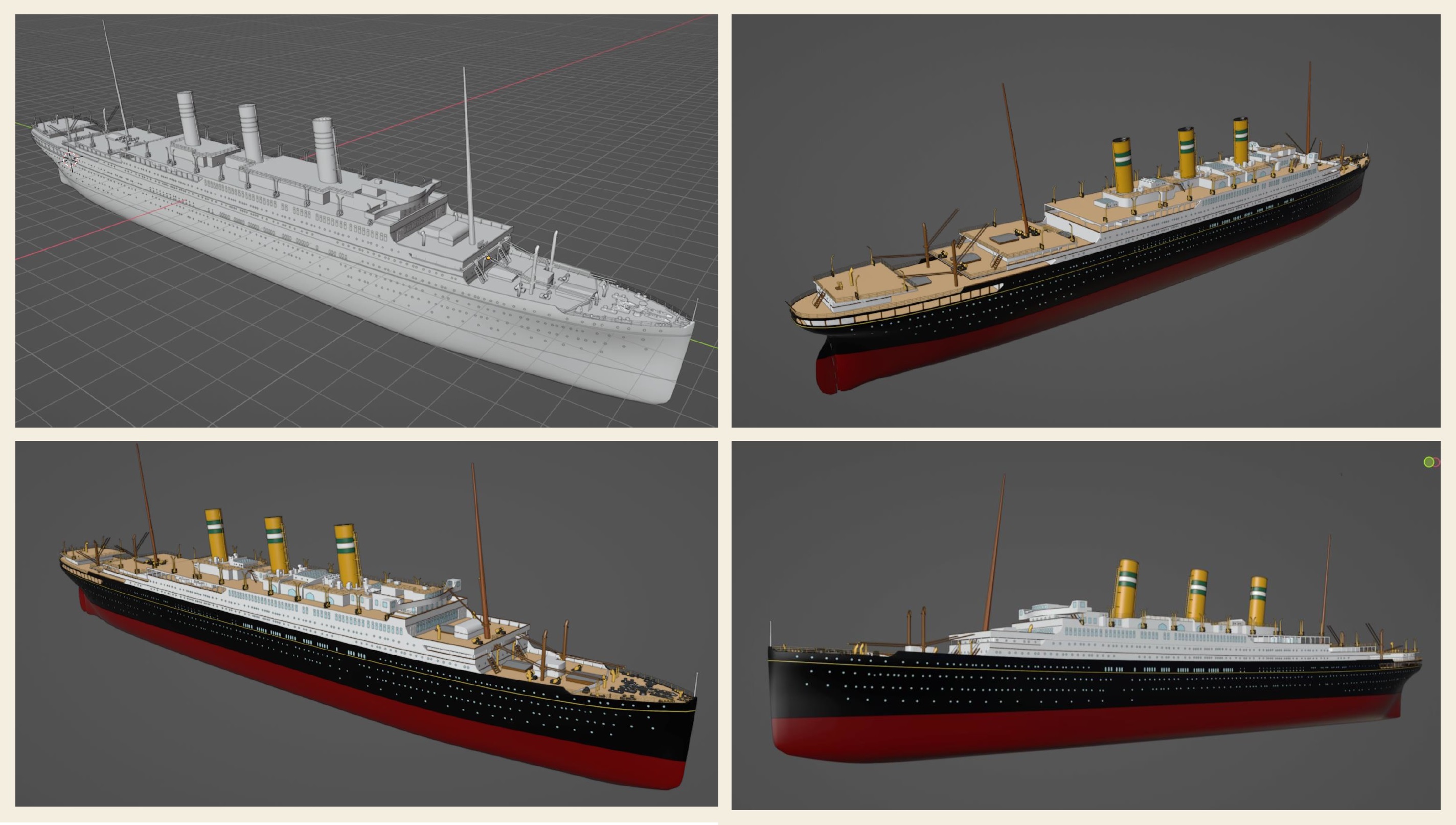
2. ábra: Az elkészült, még felfestés nélküli nyers modell (balra fent) és a modell különböző nézetei a színek és a textúra hozzáadását követően (balra lent és jobbra). Watanabe Yumi jóvoltából.
A játék a Kis Hajósok Világa (Tiny Sailor’s World - TSW), egy Roblox-játék, ahol minden játékos a saját kedvenc, valóban létezett hajókról mintázott hajóit vezetheti egy virtuális világban. (A Roblox egy online játékplatform és játékkészítő rendszer, amelyet a Roblox Corporation fejlesztett, s amely lehetővé teszi a felhasználók számára, hogy játékokat programozzanak és más felhasználók által készített játékokkal játsszanak. Ebben az értelemben tehát a TSW egy ún.: sandbox-game, azaz olyan játékelemekkel rendelkező videojáték, amelyben nem egy előre meghatározott célt kell elérni, ehelyett nagyfokú kreativitást biztosít a játékosoknak, akik szabadon fedezhetik fel az előttük álló lehetőségeket, léphetnek kapcsolatba egymással, illetve módosíthatják a játék környezetét, vagy céljait). A STATENDAM (II) esetében a modellezés nagy részét a TSW instruktora (a „GalaxyExpress” nevű felhasználó) végezte Yumi Watanabe segítségével, aki a tervek értelmezésével és referencia-modellek készítésével segítette a munka sikerét.
2024. április elején a TSW számára fejlesztett 3D modell már a sétafedélzet szintjéig elkészült, s azon az általános elrendezés olyan részleteit kellett finomítani, mint a sétányok belső falainak nyílászáró-rendszere, a csónakfedélzeti felépítmények pontos körvonala és magassága, vagy éppen a fedélzeti szellőzők száma, mérete és típusa, illetve a kikötőbakok és kötélterelők száma és pozíciója. 2024. április 14-én még javában zajlott a munka, amikor a következő levél érkezett: „Köszönöm, Balogh úr! Hálás vagyok, hogy ennyi időt szánt arra, hogy válaszoljon a STATENDAM-mal kapcsolatos kérdéseimre. Tudom, hogy elfoglalt ember, ám én annak köszönhetően váltam azzá, aki vagyok, hogy mégis így tett: Ön miatt járok ma egy hajóépítő mérnöki tanfolyamra, uram, s ezt nem tudom elégszer megköszönni. Hamarosan hajnalodik, így aludnom kell, de még egyszer köszönöm, hogy inspirált. Üdvözlettel: Watanabe”.

3. ábra: A renderelt objektum különböző szögekből. Watanabe Yumi jóvoltából.
Kivételes alkalom egy írónak, ha szembesülhet a munkája által másokra gyakorolt (az Olvasók által az írásai olvasásának tulajdonított) hatással. Watanabe Yumi eszerint azért választotta a hajótervező szakmát, mert a STATENDAM története inspirálta (az a történet, amelyről a könyvem megjelenésekor és arról értesülve, az internetről szerzett tudomást, úgy, hogy a könyv a mai napig nincs meg neki, így döntően a saját erőfeszítései révén tett szert a hajóra vonatkozó részletes tudásra, amelyet rendszeres levelezéseink kiegészítettek). Ebben a pillanatban – a levél olvastán – egyszeriben én kerültem az Olvasó pozíciójába (hirtelen nekem jutott a feladat, hogy végig gondoljam személyes viszonyomat az olvasottakhoz).
Nem tudtam másra gondolni, mint hogy ilyen kicsi hely lett a világ. A KAISERIN ELISABETH cirkáló történetéről szóló könyvem írásakor volt már szerencsém személyesen kutatni Japánban, ahol az első világháborúban elsüllyesztett cirkáló legénységének túlélő tagjai a hadifogságukat töltötték. Akkor ismerkedtem meg Atsushi Otsuru úrral, a kobei egyetem történész-professzorával, akinek nyitottsága és segítőkészsége nagy hatást gyakorolt rám és alapvetően hozzájárult ahhoz, hogy felkereshettem az egykori onói hadifogolytábor területét és még meglévő épületeit. Tizennégy évvel az akkori kutatást követően Watanabe Yumi levele arra emlékeztetett, hogy egyáltalán nem elképzelhetetlen az egymástól jelentős földrajzi távolságra fekvő olyan országok, mint Japán és Magyarország polgárai számára az, hogy kölcsönösen inspirációt nyerjenek egymás lelkesedéséből.
A STATENDAM 3D modellje 2024. április 24-re elkészült, és május 18-án, a csatlakozott felhasználók számára elérhető módon, közzé is tették a játékban.
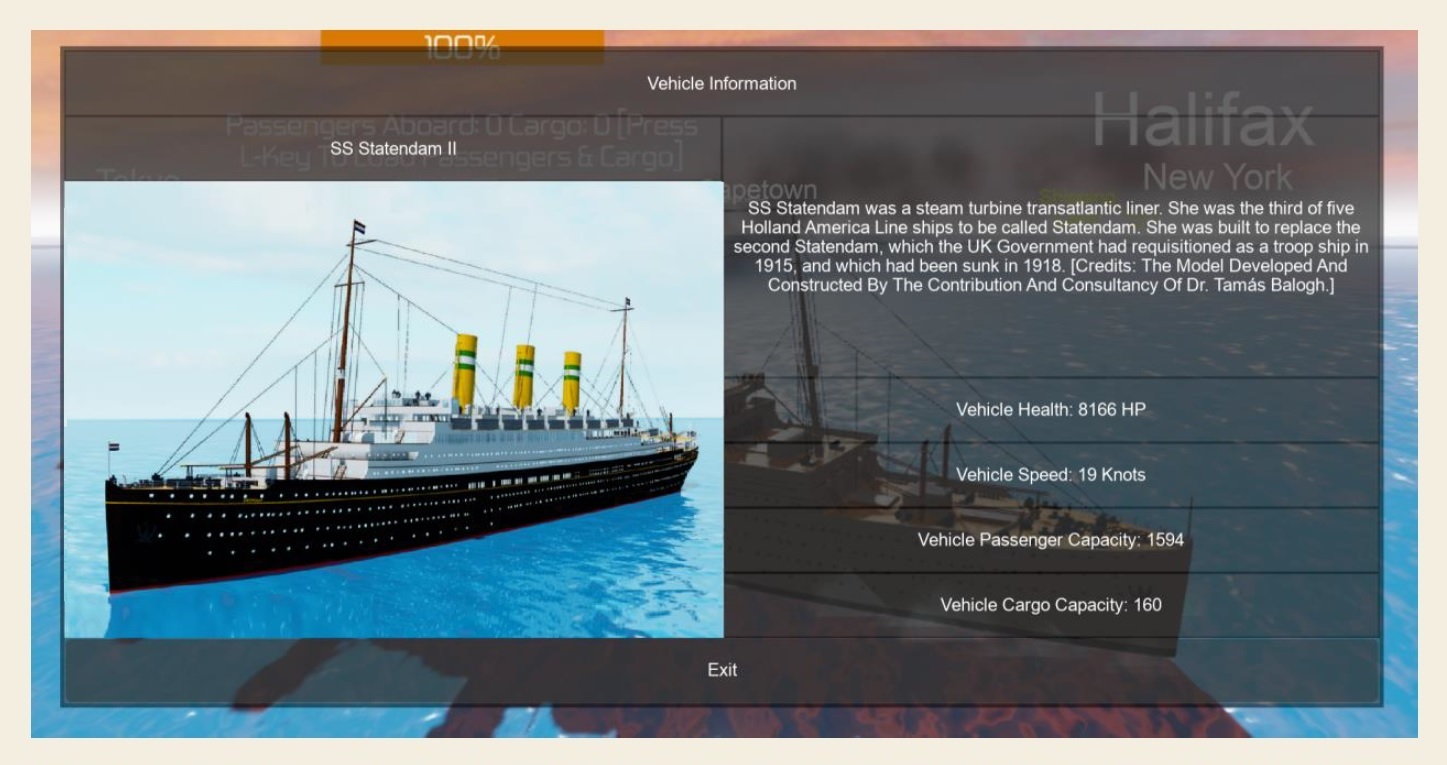
4. ábra: A játékban elérhető új modell adatlapja. Watanabe Yumi jóvoltából.
A jól sikerült alkotás játékosok számára élvezhető kialakítását nemcsak a külső ábrázolás pontossága adja, de az is, hogy – a játékban szereplő összes többi óceánjáróhoz hasonlóan – a belső terei közül legalább három helyiséget belülről is bejárhatóvá kellett tenni, vagyis részletesen ki kellett dolgozni. A játékban jelenleg 71 hajó és 15 repülőgép elérhető (a hajók közül 26 ingyenesen). Kétség sem férhet hozzá, hogy a STATENDAM (II) története a játék révén még szélesebb kör számára válik megismerhetővé, s ez elsősorban Watanabe Yumi érdeme, aki ismereteivel és képességeivel járult hozzá a hajó 3D modelljének pontos és részletgazdag, ezért a szemnek is kellemes, izgalmas formába öntéséhez. Az a mód és az elszánt, hozzáértő lelkesedés, amivel ezt tette, a munka eredményével együtt igazolta mindazt, amit korábbi levelemben írtam neki, 2023. május 17-én (amikor kiderült, hogy a dokumentumfilm forgatására nem kerülhet sor): „Tisztelt Watanabe úr! Sajnálattal olvastam, hogy a jelenlegi korlátok miatt nem sikerül elkészítenie a tervezett dokumentumfilmet. Mindazonáltal úgy gondolom, hogy az a lelkesedés, amit az Ön részéről tapasztaltam, fiatal kora ellenére biztosan megtalálja majd az időt és módot arra, hogy előbb vagy utóbb megfelelő kifejezést nyerjen. Számomra különösen nagy élmény volt látni, hogy Japánban felébredt az érdeklődés a STATENDAM/JUSTICIA története iránt, amit Ön is fokoz a munkájával, így teljesen természetes számomra, hogy a lehetőségek határain belül elérhetővé tegyem Önnek mindazokat az információkat, amelyekre szüksége lehetett érdeklődése kielégítéséhez. Amennyiben a jövőben is érdekli a téma, akkor megtalál. Minden jót kíván: Balogh Tamás”
A végeredményt látva úgy gondolom, hogy a megfelelő kifejezésmód megtalálása megtörtént. A kész modellről készült képek alapján (melyeket a készítők jóvoltából most a játékon kívül is megoszthatok olvasóinkkal) pedig mindenki maga is eldöntheti, vajon tényleg így történt-e.
Gratulálunk az alkotóknak, további munkájukhoz pedig sok sikert és jó egészséget kívánunk!
-
Páratlan erőfeszítéssel megújult az óceánjáró-történelem egyik híres papírrégisége
Új hírek érkeztek a Németalföldről. Peter Meersman gyűjtő anyagi hozzájárulásával megújult a híres s.s. STATENDAM (II) - később JUSITCIA - óceánjáró 1913-ban készült hosszmetszete, amelyből csupán kilenc ismert példány maradt fenn az egész világon.
2018-ban, napra pontosan a hajó elsüllyesztésének centenáriumán jelent meg egyesületünk elnöke, Dr. Balogh Tamás könyve a STATENDAM néven vízrebocsátott, JUSTICIA néven elsüllyedt holland megrendelésre épült, végül az első világháborúban a brit hadiszállításokban szolgáló óceánjáró történetéről, annak legelső monografikus összefoglalásaként.A könyvhöz sok képet biztosított Peter Meersmann belga gyűjtő, aki nem sokkal a kézirat lezárását és nyomdába adását követően tett szert egy korabeli, hatalmas színes hosszmetszetre a hajóról, ami a súlyos sérülései miatt kiterjedt restaurálásra szorult. Peter már a könyv elkészítésekor tanúbizonyságot tett az óceánjárók iránti kivételes lelkesedéséről és gyűjtői elkötelezettségéről, amikor a könyvkiadást nagyszerű gyűjteménye rendelkezésre bocsájtásával segítette. A hosszmetszet beszerzésével és a restaurálás költségeinek biztosításával azonban, ha ez egyáltalán lehetséges, még nagyszerűbb dolgot vitt véghez, hiszen a STATENDAM eredeti holland megrendelésre készült promóciós anyaga részeként elkészült ezen hosszmetszetből - amelyet a Holland-America Line rajzirodája számára 1913 körül készített L. Ph. Baijens – a jelenlegi tudomásunk szerint világszerte csupán 8 példány maradt fenn (ezek egyikét a Rotterdami Városi Múzeum őrzi). Így ez a grafikus ábrázolás bizonyos értelemben az óceánjáró-rajongók igazi „fehér unikornisa”.
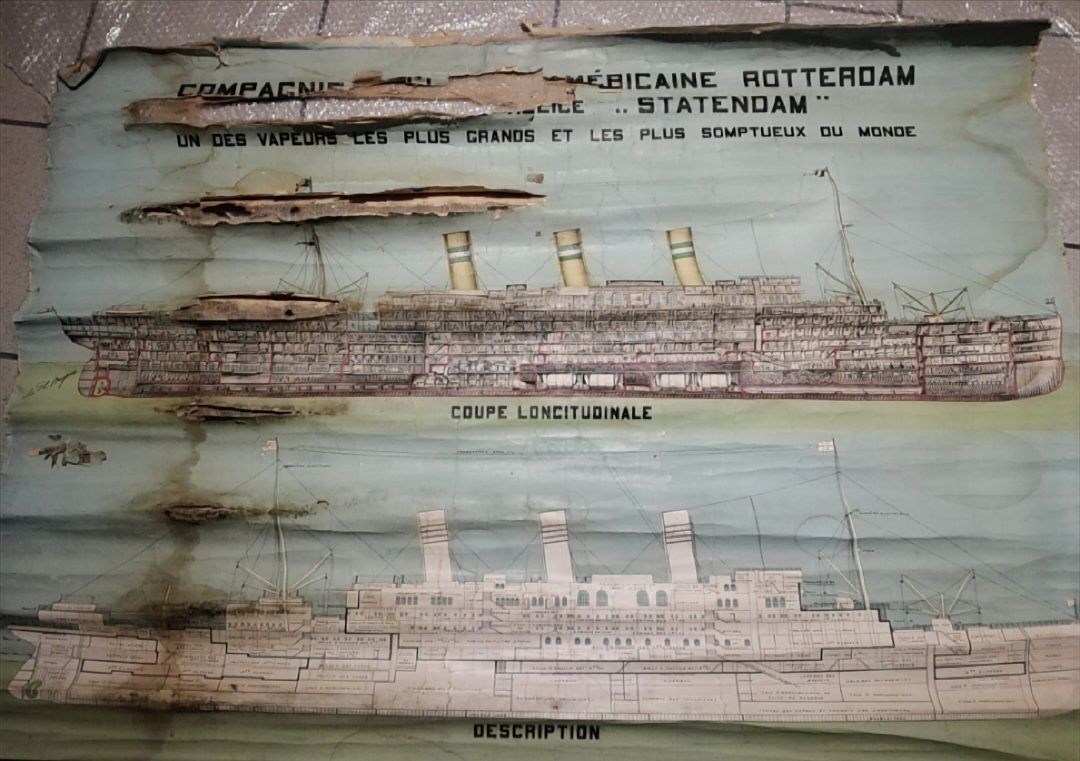
1. ábra: A műtárgy a szerzeményezéskor (fotó: Peter Meersman).
A 2019-ben beszerzett hosszmetszet hozzáértő restaurátori kezekben 4 évig tartó munkával 2024. márciusában nyerte vissza az eredetit megközelítő állapotát. A restaurátornak hihetetlenül aprólékos munkával sikerült helyreállítani és konzerválni a nagyméretű alkotást. A rajzot az elkészülte óta eltelt több, mint száz évben kialakult anyaghiányok miatt először is stabilizálni kellett, ezért fátyolvékonyságú japán-papírral erősítették meg (a japán-papír azért alapvető anyaga a restaurálásnak, mert hosszú rostokból épül fel, s ezek a hosszú sortvégek könnyebben hozzádolgozhatók az eredeti papírfelülethez). Az anyaghiányok megszűntetését követően pedig helyenként újra kellett rajzolni a megsérült ábrát az eredetinek megfelelő karakterekkel és színezéssel.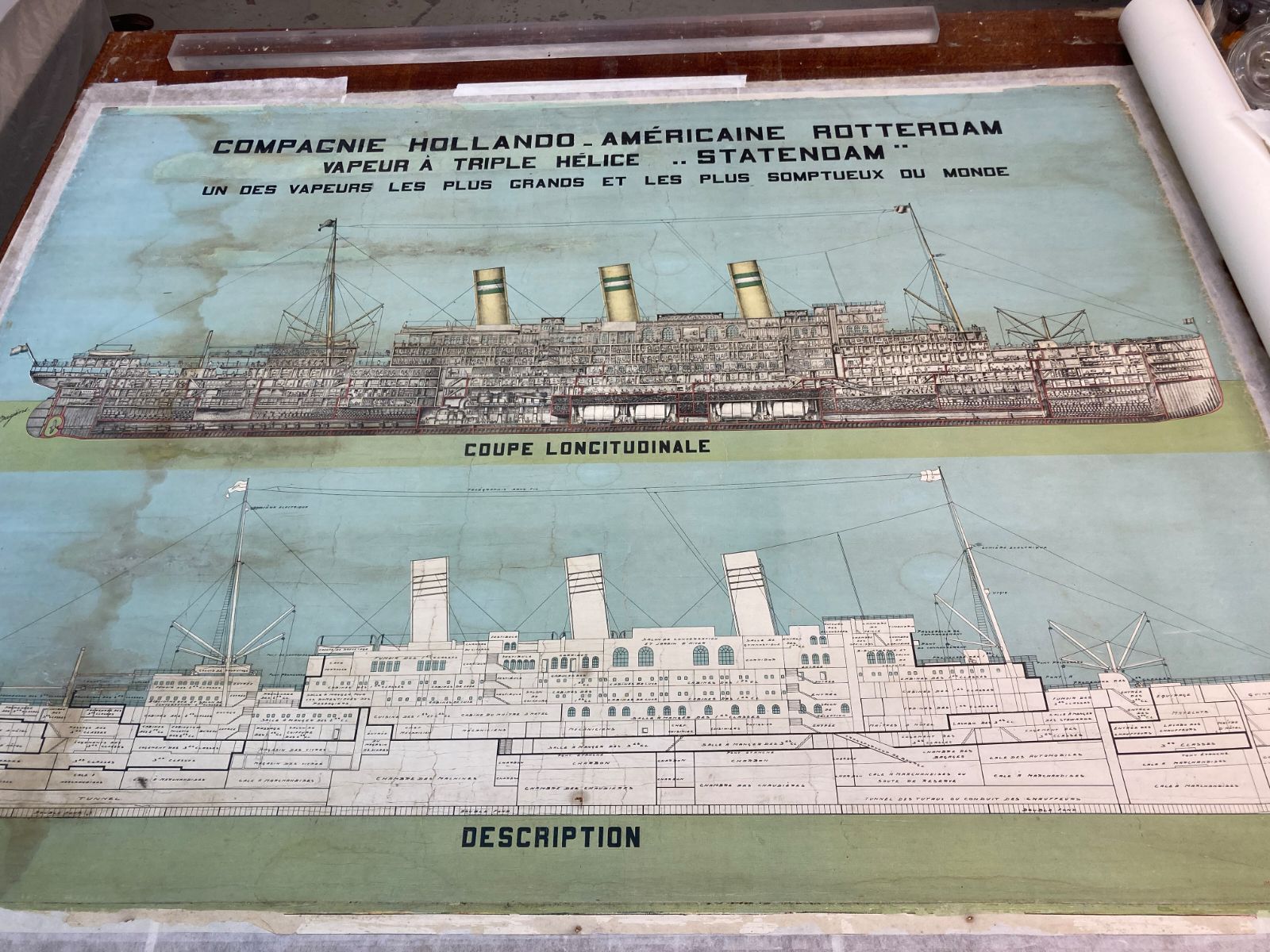
2. ábra: A műtárgy a restaurálást követően (fotó Peter Meersman).
Az elkészült mű érdekes módon felidézi a hajóépítés egykori folyamatát, egyben páratlanul érdekes kordokumentum. Ahogyan Peter Meersman fogalmazott: „Örülök a helyreállítás eredményének. Óriási a különbség a 4 évvel ezelőttihez képest. Örülök, hogy sikerült megmenteni, mivel tudván, hogy ezen kívül csak nyolc másik létezik, nagyon fontos volt, hogy fennmaradjon ez a nagyon ritka metszet. Valójában ez a gyűjteményem koronája.”Szívből gratulálunk a gyűjtő és a restaurátor együttműködésében megvalósult értékmentéshez!
-
Pillantás a rajzirodába – óceánjárók dokumentumfilmes animációja
2021. április 1-én Max Barber, a londoni székhelyű Born This Way Media Kft. kreatív igazgatója azt a kérdést intézte Dr. Balogh Tamáshoz, hajózástörténészhez és hajóroncs-kutatóhoz, az Óceánjáró-enciklopédia szerzőjéhez, hogy bekapcsolódna-e egy 6 – egyenként 60 perces – epizódból álló dokumentumfilm-sorozat gyártásába, amely az „Elveszett óceánjárók – paloták a tengerfenéken” munkacímmel éppen belépett az előgyártás szakaszába. Balogh Tamás a történeti és műszaki elemzések szakértőjeként, valamint a műszaki rajzok készítőjeként és az animációk tervezőjeként kapcsolódott be a projektbe, amelynek általa kezelt részleteibe enged bepillantást az alábbiakban.
I.) Miről szól és hogyan jött létre a sorozat?
A legtöbb embernek az „óceánjáró” szó hallatán a TITANIC jut az eszébe. A végül „Az elveszett óceánjárók titkai” (Secrets of The Lost Liners) címen forgalomba hozott alkotás azonban arra törekszik, hogy kiszabadítsa a fogalmat ennek az egyetlen hajónak az árnyékából és mélyreható tengerészettörténeti sorozatként hiteles képet adjon a világ legnagyobb óceánjáróinak tervezéséről, szolgáltatásairól és elvesztéséről. A sorozat így az elmúlt 100 évben háború, baleset, vagy emberi tévedés eredményeként elsüllyedt leghíresebb óceánjáró személyszállító hajók – a CAP ARCONA (1927-1945), a NORMANDIE (1932-1948), a REX (1931-1944), a QUEEN ELIZABETH (1938-1972), az AMERICA (1939-1994) és az ANDREA DORIA (1951-1956) – történetét dolgozza fel az események történeti kronológiája mellett a hajók tervezésének és biztonsági rendszereinek fejlődését is bemutatva.
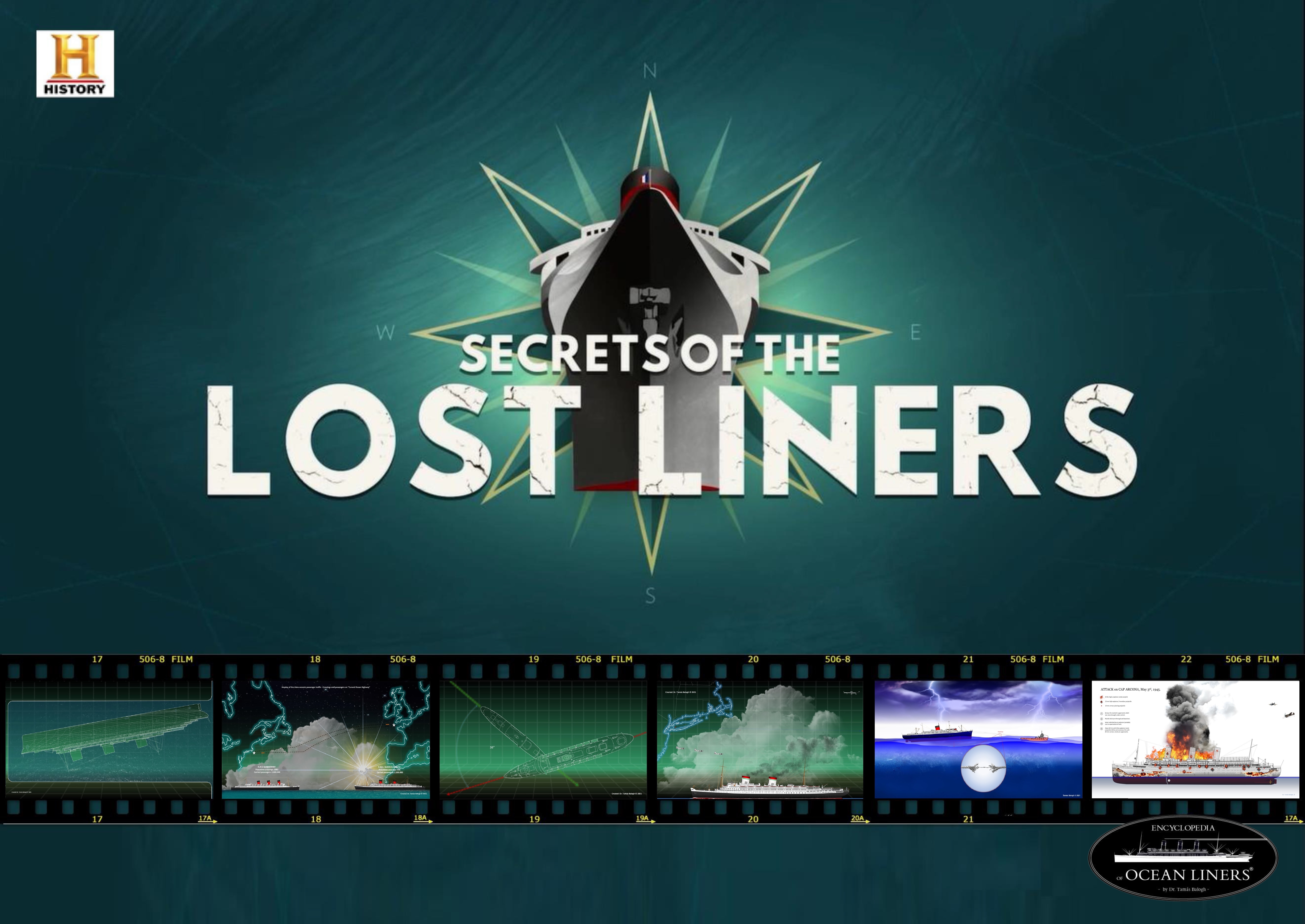
1. ábra: A sorozat főcíme. A sorozat előzetese és az első epizód megtekinthető itt.
A sorozat az ismeretterjesztő televíziós műsorok piacán 2020. június – 2021 november folyamán végbement jelentős átalakulásnak köszönhetően jöhetett létre, amikor az amerikai Arrow Media létrehozta az amerikai és az Egyesült Királyságbeli dokumentumműsorok és tartalomszolgáltatók új platformját, illetve amikor a német Herbert L. Kloiber Night Train Media nevű vállalkozása felvásárolta a televíziós jogok forgalmazójaként, televíziós alkotások társproducereként, társfejlesztőjeként és ügynökeként működő brit BossaNova Media Ltd-t. Kettejük együttműködésében hozták létre azt a beszerzési pénzalapot, amely a korszerű dokumentumfilmek immár a második nagy sorozatát hozza létre. Ennek a sorozatnak a részeként jött létre „Az elveszett óceánjárók titkai” első 6 epizódja, amelyet a tervek szerint további részek követnek.
Az alkotó-csapatot a dokumentumfilm-gyártásra specializálódott független alkotókat tömörítő brit Content Kings Ltd. Production és a Born This Way (Így születtek) Media Ltd. munkatársai, Jason Davidson és Peter Roch producerek és rendezők, illetve Max Barber társproducer alkotta, akik a History Channel mellett egyebek közt a BBC, az ITV, a C4, a Channel 5, a Sky, a FOX, az NBC, a Paramount, a National Geographic, a Facebook Watch, a Netflix és a YouTube Originals számára készítenek műsorokat.
II.) Miért és hogyan sikerült magyarként bekapcsolódni a munkába?
Mivel Max Barber értesült Balogh Tamásnak az óceánjárók történetét bemutató projektjéről, amely a világ legnagyobb digitális hajóprofil-gyűjteményének létrehozását eredményezte, azt feltételezte, hogy az alkotó képes lehet bekapcsolódni a filmgyártásba.
A fején találta a szeget: miután egyeztették a részleteket – azt, hogy pontosan mire van szükség a produkcióban – Balogh Tamás szívesen mondott igent a megtisztelő felkérésre, hiszen az általa elvégzett munka eredményeként mintegy 20 ország 100 hajótársaságának 1830-2003 között épült 500 óceánjárójának digitális megformálására került sor Ezen kívül 6 ország 7 hajótársaságának 12 hajója esetében nemcsak a végül megvalósult, de az előzetes terveket is feldolgozta, továbbá 2 olyan hajót is megrajzolt, amelyet ugyan elkezdtek építeni, de végül sohasem fejeztek be, és 3 olyat is, amelyet hadihajóvá építettek át. Végül 7 ország 17 hajótársasága által megrendelt 27 olyan hajó jellegrajzát is elkészítette, amelynek a felépítéséhez végül sohasem kezdtek hozzá.
Ez a munka több célt szolgál egyszerre. Egyrészt az általános ismeretterjesztési célok keretében hozzájárul egy, az óceánjárók történetéről szóló nagy képes enciklopédia kiadásához, valamint különböző, az óceáni személyhajózással kapcsolatos kiállítások szervezéséhez, a szükséges 2D-s grafikus megjelenítés biztosításával. Másrészt kifejezetten azzal a céllal jött létre, hogy a hajók 3D-s megformálása révén az óceánjárók filmes produkciókban történő hiteles, egyben részletgazdag megjelenítését támogassa.
Ez a gyűjtemény a legutóbb Enyedi Ildikó rendező alkotása, a Füst Milán regényéből készült „A feleségem története” c. film elkészítéséhez nyújtott segítséget, amelyet 2021-ben a Cannes-i Filmfesztiválon Arany Pálma díjra, a Sydney Filmfesztiválon a fesztivál díjára, 2022-ben a Keralai Nemzetközi Filmfesztiválon közönségdíjra, a Zsigmond Vilmos fesztiválon pedig a legjobb alkotás díjára jelöltek, s amely 2021-ben az Otrantói Filmfesztiválon a zsűri különdíját nyerte. A filmben szereplő hajókat Balogh Tamás tervezte, s a KGB Stúdió munkatársai keltették életre Klingl Béla vezetésével. A tervezési folyamat részleteiről itt olvashatnak.
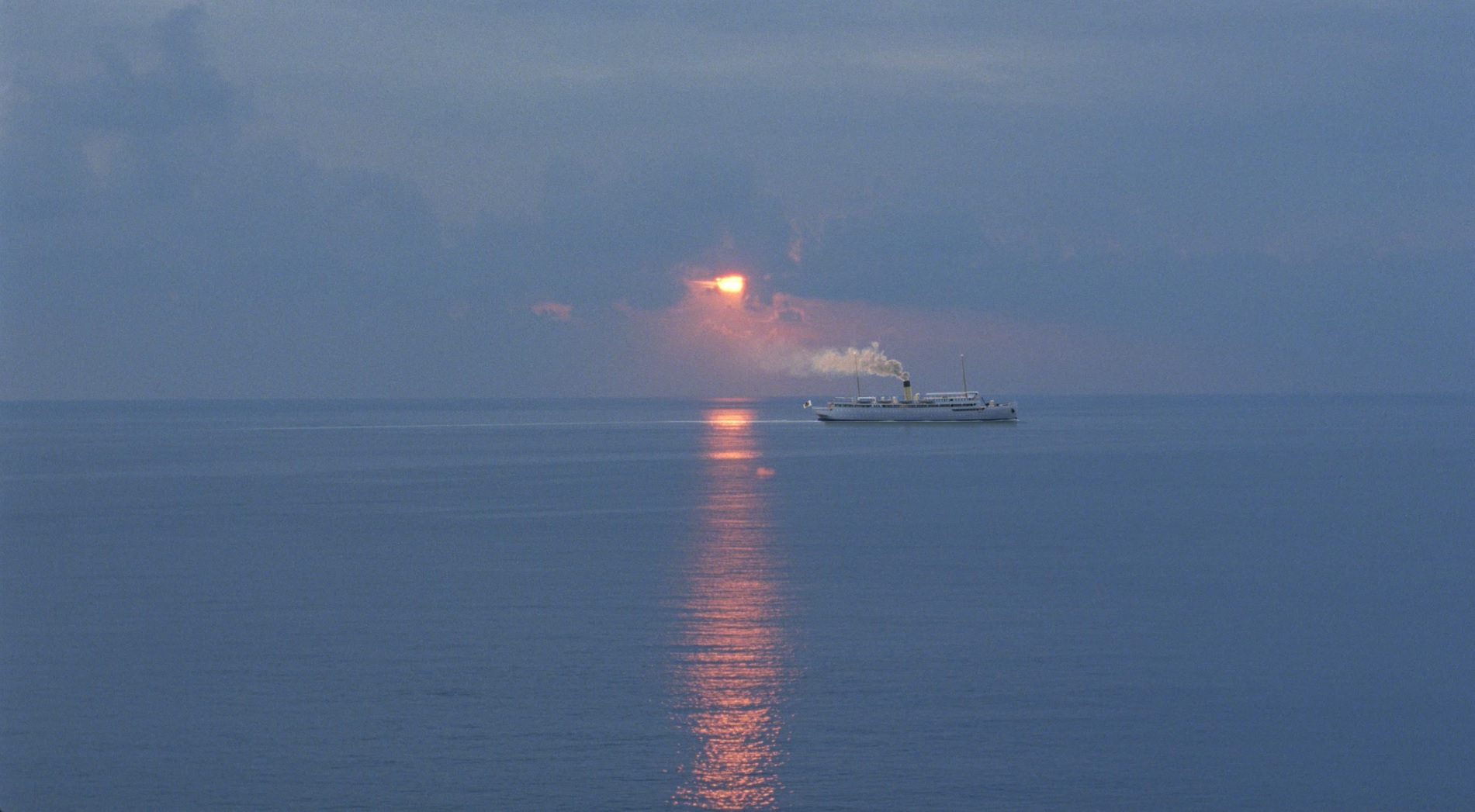
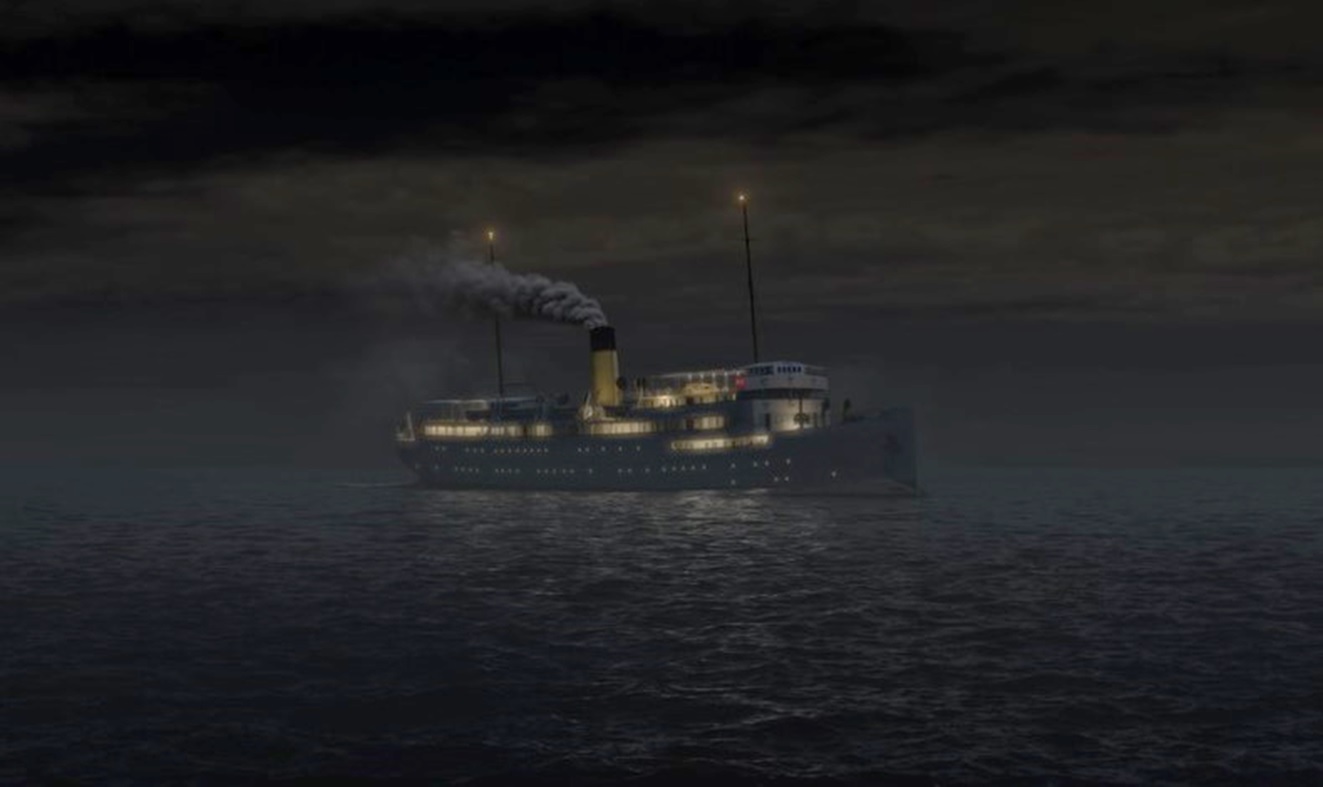
2. ábra: A Balogh Tamás tervezte óceánjáró a film egyik jelenetében. További műhelytitkok az alkotás werkfilmjében 1:02-től.
Az egyedülállóan hatalmas és pontos digitális adatbázis jelentette azt a megfelelő alapot, amely, a korábbi referenciákkal együtt alkalmassá tették az alkotót arra, hogy magyarként lehessen részese az alkotófolyamatnak munkatársaival, a műszaki rajzok digitális animációinak gyártása során animátorként közreműködő Gyurik Benettel és a vizuális hatások részleteinek felülvizsgálatáért felelős a Könczöl Péterrel (post-production supervisor) közösen egy olyan filmsorozatban, amelyben a világ legelismertebb szakértőivel dolgozhatott együtt. Hiszen a filmsorozat stáblistáján egyebek között az óceánjárók történetének olyan elismert kutatóinak a neve is szerepel, mint a brit Mark Chirnside, vagy éppen a világ ez idő szerint egyetlen forgalomban álló valódi óceánjárója, a QUEEN MARY 2 tervezője, Dr. Stephen Payne, a Brit Birodalom Rendjének tisztje. A filmsorozat minőségéről az is sokat elárul, hogy a műsorkészítéshez a legkiválóbb szakértők mellett a leggazdagabb közgyűjtemények – egyebek közt az Egyesült Államok Nemzeti Levéltára és Kongresszusi Könyvtára, a Tengerészeti Tervezők Királyi Intézete, vagy épp a French Line archívuma – anyagát is sikerült biztosítani.
III.) Hogyan jött létre a digitális tervrajzgyűjtemény?
Balogh Tamás még gyermekkorában, a ma általa vezetett TIT Hajózástörténeti, Modellező és Hagyományőrző Egyesületet 1979-ben megalapító Marjai Imre „Nagy hajóskönyv” c. alkotása és az abban látható, a süllyedő TITANIC-ot ábrázoló Willy Stöwer-kép hatására vált az óceánjárók szerelmesévé, s kezdett maga is rajzokat készíteni a különböző hajótípusokról, az óceánjárókat is beleértve.
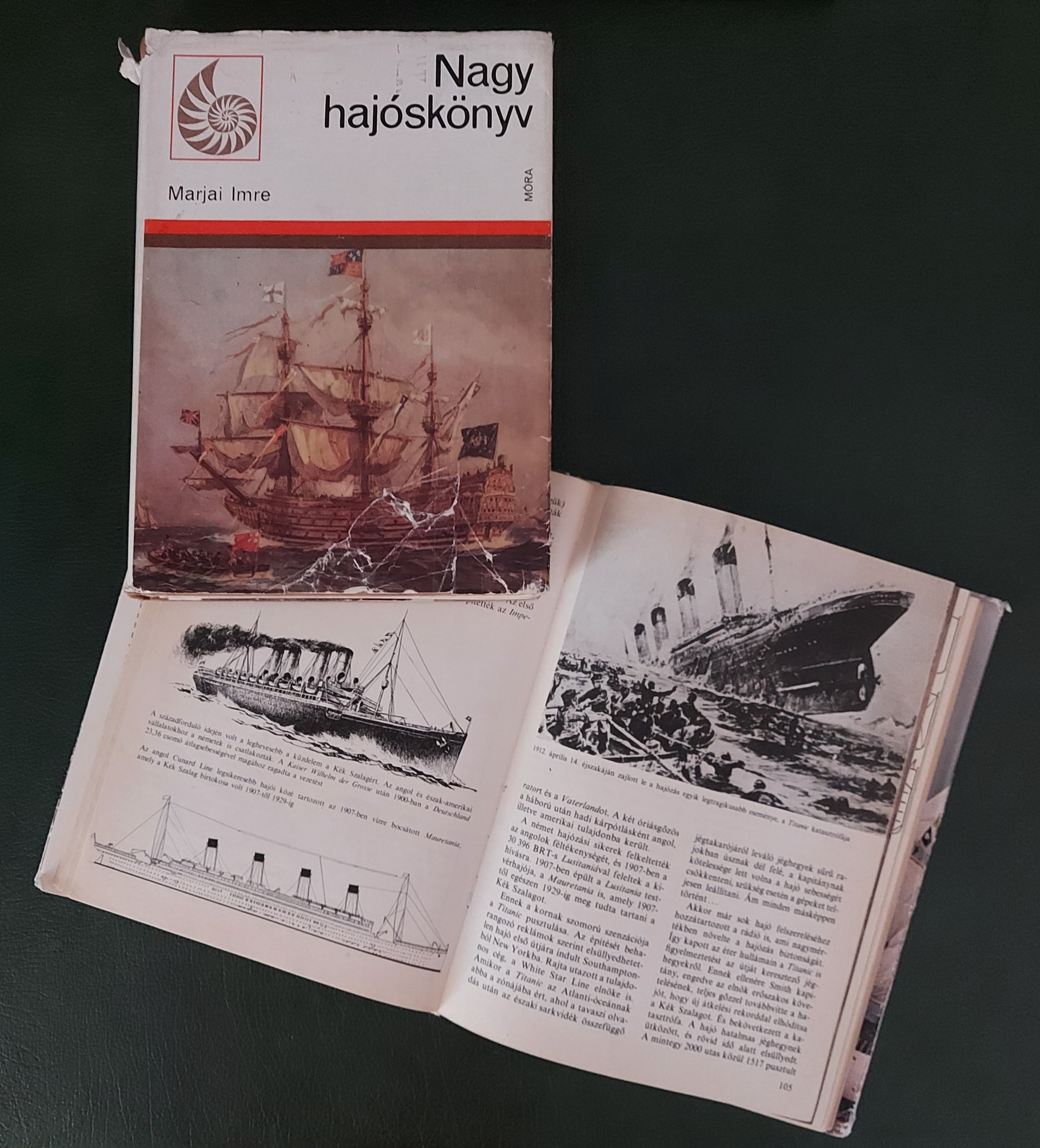
3. ábra: Marjai Imre: Nagy hajóskönyv (Móra Kiadó, Budapest, 1981). A bal oldalon a szerző saját rajza a német DEUTSCHLAND óceánjáróról, a jobb oldalon Willy Stöwer festménye a TITANIC katasztrófájáról.
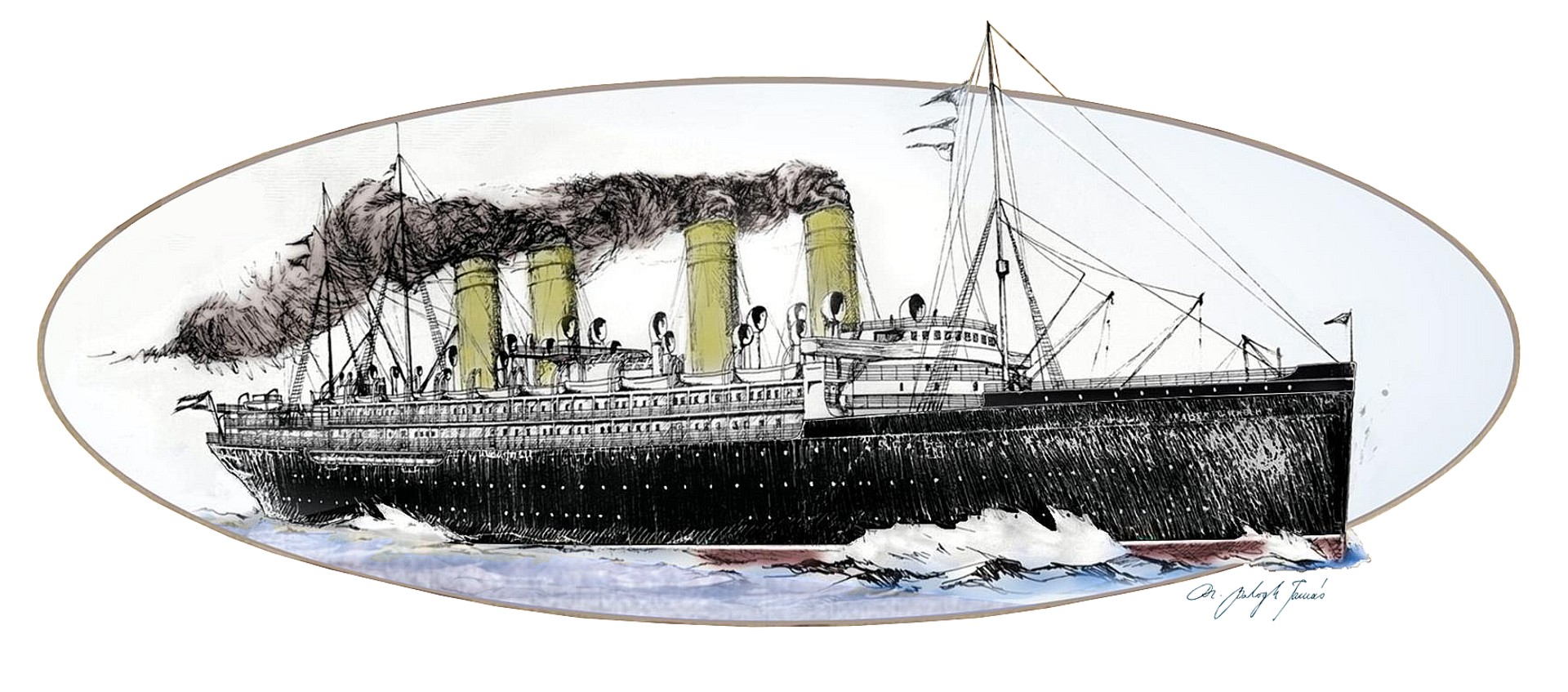
4. ábra: A KAISER WILHELM II óceánjáró. A magyar Marjai Imre (1912-2005) és az amerikai Francis Osborn Braynard (1916-2007) stílusában készült színezett tollrajz Dr. Balogh Tamás munkája.
A hajókat térben ábrázoló perspektivikus – nézeti – rajzok mellett azonban számtalan oldal- és felülnézeti rajz, a különböző hajók méreteinek összehasonlítására vagy éppen egyes részleteik elemzésére szolgáló vázlat is készült.
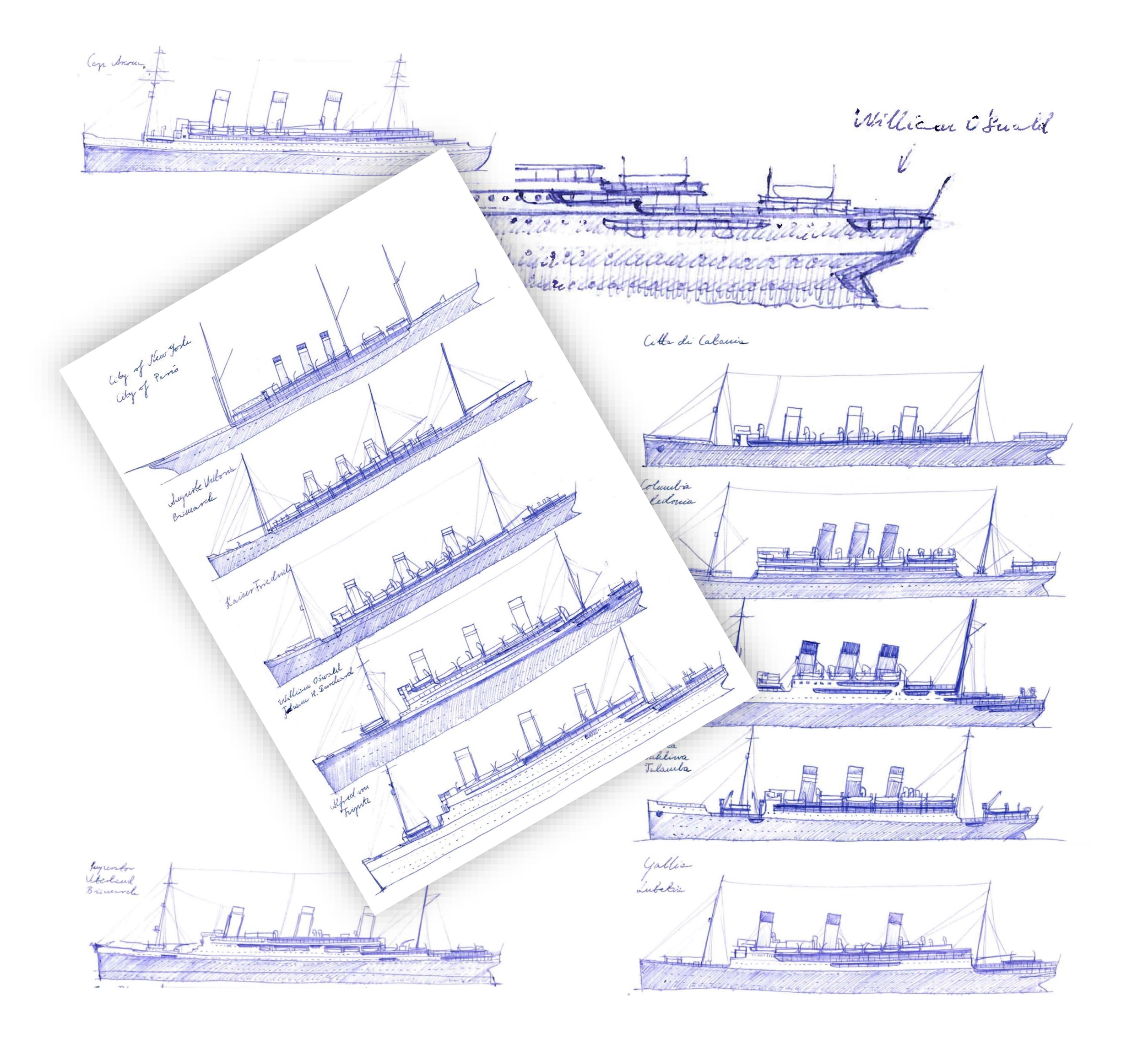
5. ábra: Az arányok és a részletek tekintetében a későbbi alkotó tevékenységhez szükséges tájékozódást segítő vázlat-rajzok (Dr. Balogh Tamás).
Minden ehhez hasonló vázlatokkal kezdődik. Ezek segítenek mélyen bevésni a formát, egyúttal azt is tudatosítják, hogy melyek azok a részletek, amelyeket még sikerült eléggé alaposan megismerni, ezért további információkat kell szerezni róluk.
Ezt követően kezdődik a hiányzó információk összegyűjtése, ami olykor évekig is eltarthat. Hiszen fel kell keresni a hajó eredeti terveit őrző archívumokat, a gyári modelleket bemutató múzeumokat és fel kell kutatni a lehető legtöbb korabeli fényképet és kiadványt, amely hitelt érdemlő bemutatását adhatja a kérdéses részleteknek. A forrásként felhasznált dokumentumok – archív tervek, fotók és a hajóról készült gyári modellek - segítségével összegyűjtött információk alapján kezdődhet el aztán a rajzolás. Jól látható tehát, hogy számtalan forrás segít egy-egy apró részlet tisztázásában, míg elkészülhet egy-egy jellegrajz.
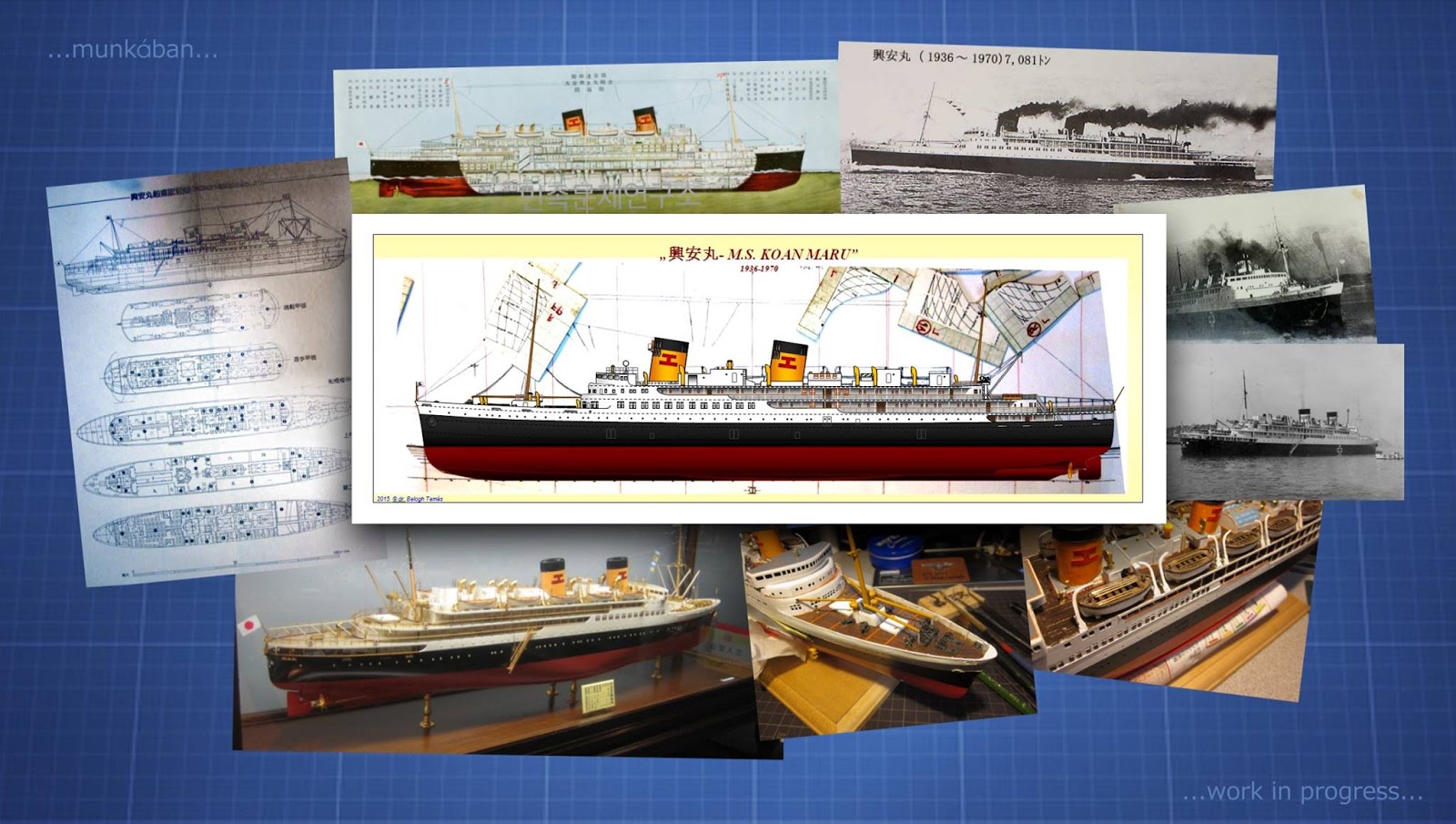
6. ábra: A digitális tervrajz készítése és forrásai a gyári tervrajzoktól és modellektől az archív fotókig (Dr. Balogh Tamás).
IV.) Hogyan készült animáció a digitális tervekből?
„Az elveszett óceánjárók titkai” c. dokumentumfilmes produkció Balogh Tamás bevonásakor az előgyártás szakaszában volt (ez a produkció tervezési szakasza azután, hogy a filmötlet „zöld lámpát” kapott, vagyis ez a főfotózás megkezdése előtti szakasz, amely általában a forgatókönyv-kezelést, az ütemezést, a szereplő-válogatást, a díszlettervezést és a pénzügyi tervezést foglalja magában). Így elegendő idő állt rendelkezésre Balogh Tamás számára ahhoz, hogy a 6 epizód mindegyikéhez megtervezhesse a látványvilágot és a bemutatni kívánt animációs elemeket.
Hamar világossá vált, hogy a gyártók nem érdekeltek három dimenziós modellek segítségével előállított CGI alkalmazásában, ezért a 2D animációk mellett döntöttek. Ehhez igazodva Balogh Tamás a műszakirajz-készítés analógiájára építette fel a teljes látványvilágot, amelyben az egyes hajók a milliméter-papír segédvonalait idéző, a háromdimenziós tér optikai illúzióját keltő rácshálós háttér elé kerültek. Minden hajóhoz három tervlapból álló tervkészlet készült, amely tartalmazta a hajók főnézeti rajzait, valamint a bordarajzát, illetve a kereszt- és a hosszmetszetét.
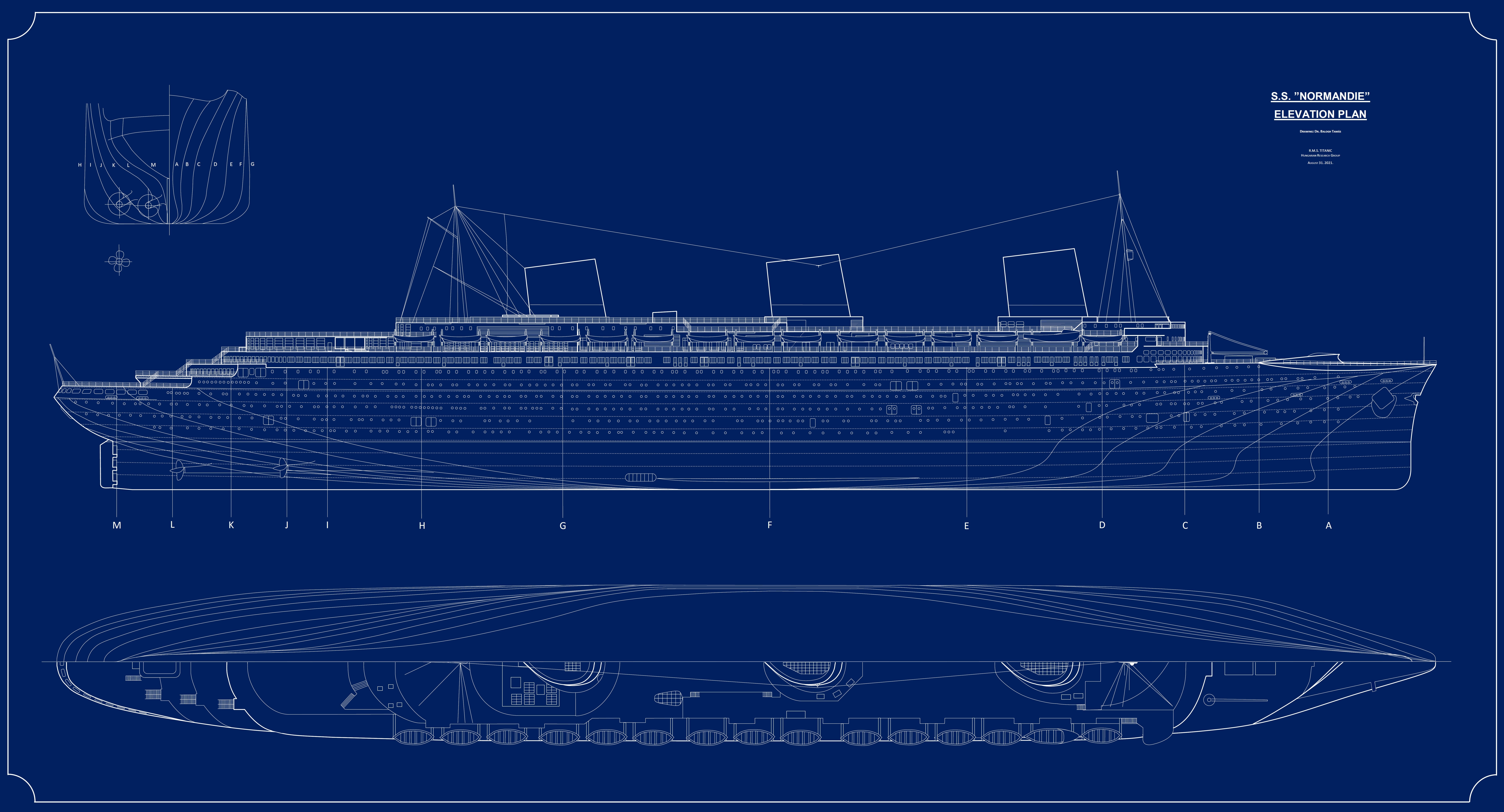
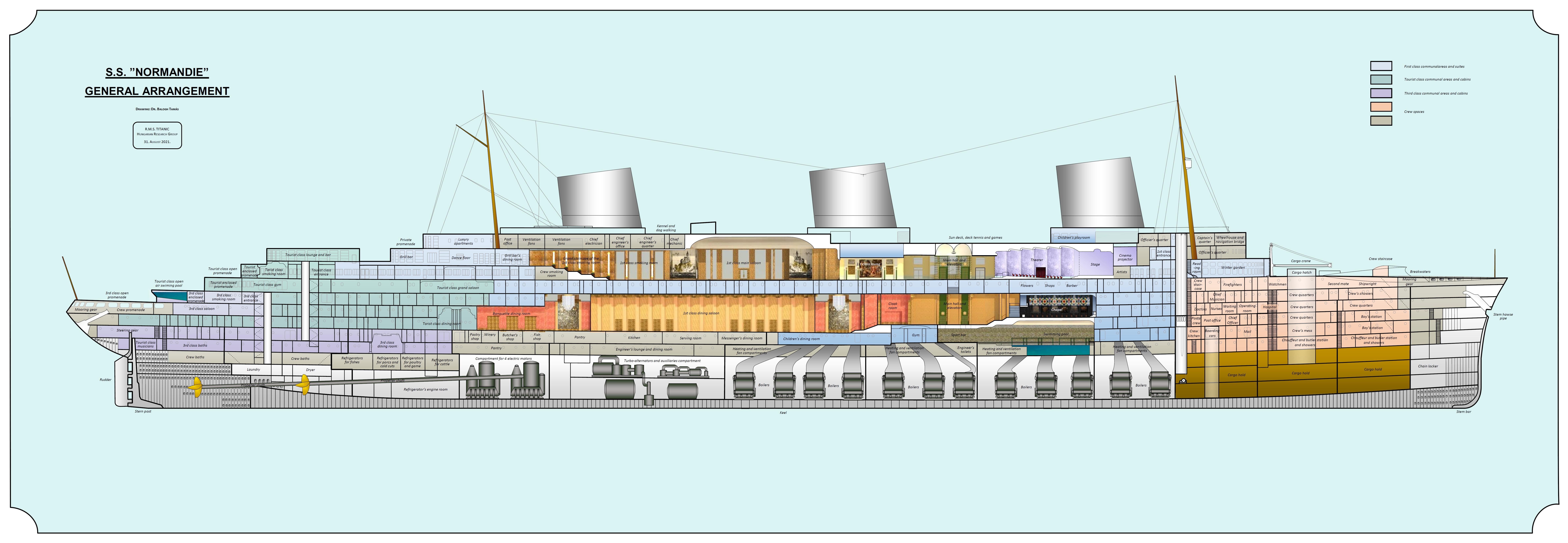

7. ábra: Digitális főnézeti tervrajzok és hosszmetszet a NORMANDIE óceánjáróról szóló epizódhoz (Dr. Balogh Tamás). További információk itt.
Ezek adták azt az alapot, amely aztán megmozdult az animáció során. Az animációs jelenetsorrendjét teljes egészében Dr. Balogh Tamás tervezte, aki az animációkat tartalmazó jelenetek forgatókönyvélt is írta. Ehhez a sorozat rendezői teljesen szabad kezet adtak, instrukcióikkal nem szorították szigorú keretek közé az alkotó folyamatot.
A forgatókönyvek elkészítését az egyes epizódokban bemutatott hajók történetének alapos elemzése, kiterjedt levéltári kutatómunka előzte meg, amely egyebek között az egyes hajók pusztulásával összefüggő hivatalos vizsgálatok eredeti jegyzőkönyveire is kiterjedt annak érdekében, hogy az animációkon egészen biztosan azt és úgy láthassák az érdeklődők, ami és ahogyan valójában történt.
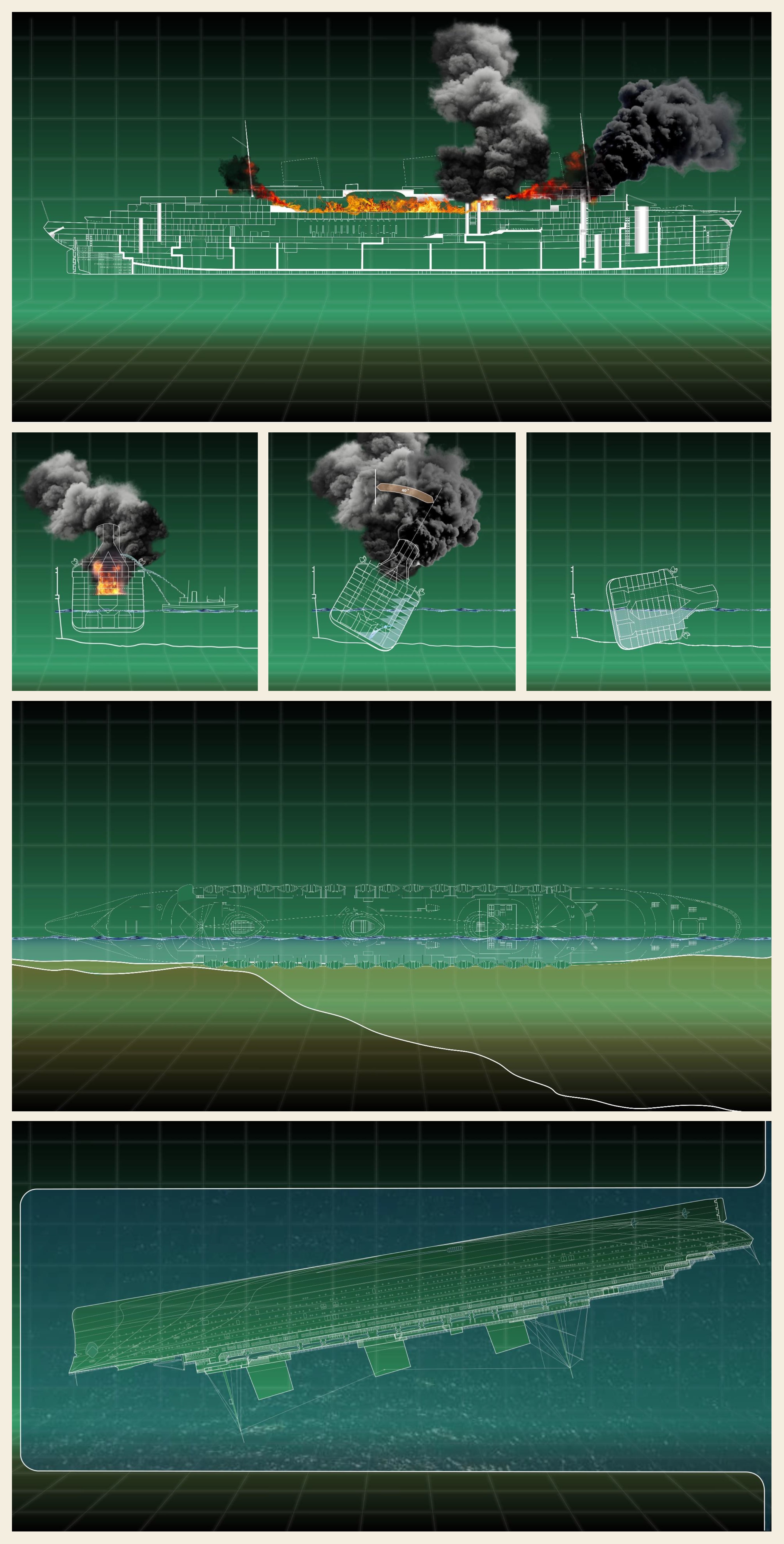
8. ábra: A NORMANDIE pusztulását bemutató animáció a tűz kitörésének helyétől kezdve a fedélzeteken történő szétterjedésén át, a hajó oltásának szakaszait és az oltóvízzel történő aszimmetrikus elárasztás miatti felborulást bemutató jelenetekig kíséri végig a hajó agóniáját (Dr. Balogh Tamás).
A gyártás ebbe a munkafolyamatba egyáltalán nem szólt bele – csak a magyar csapat által elkészített animációk megtekintése után, a filmsorozat egyes epizódjaiba történő beépítés előtt tettek észrevételeket –, s az animációkat a felhasználás érdekében szükséges kisebb-nagyobb módosításokra vonatkozó igények jelzése mellett lényegében változtatások nélkül elfogadták.
Ez az animációk alapját jelentő kutatás, az animációs forgatókönyv és a tervek minőségének elismerése mellett elsősorban az animátorként közreműködő Gyurik Benett és a minőségbiztosítás munkáját lelkes állhatatossággal végző Könczöl Péter munkáját dícséri.
A sorozat első évadának 6 epizódját 2022 tavaszán kezdik vetíteni a History Channel brit adásában.
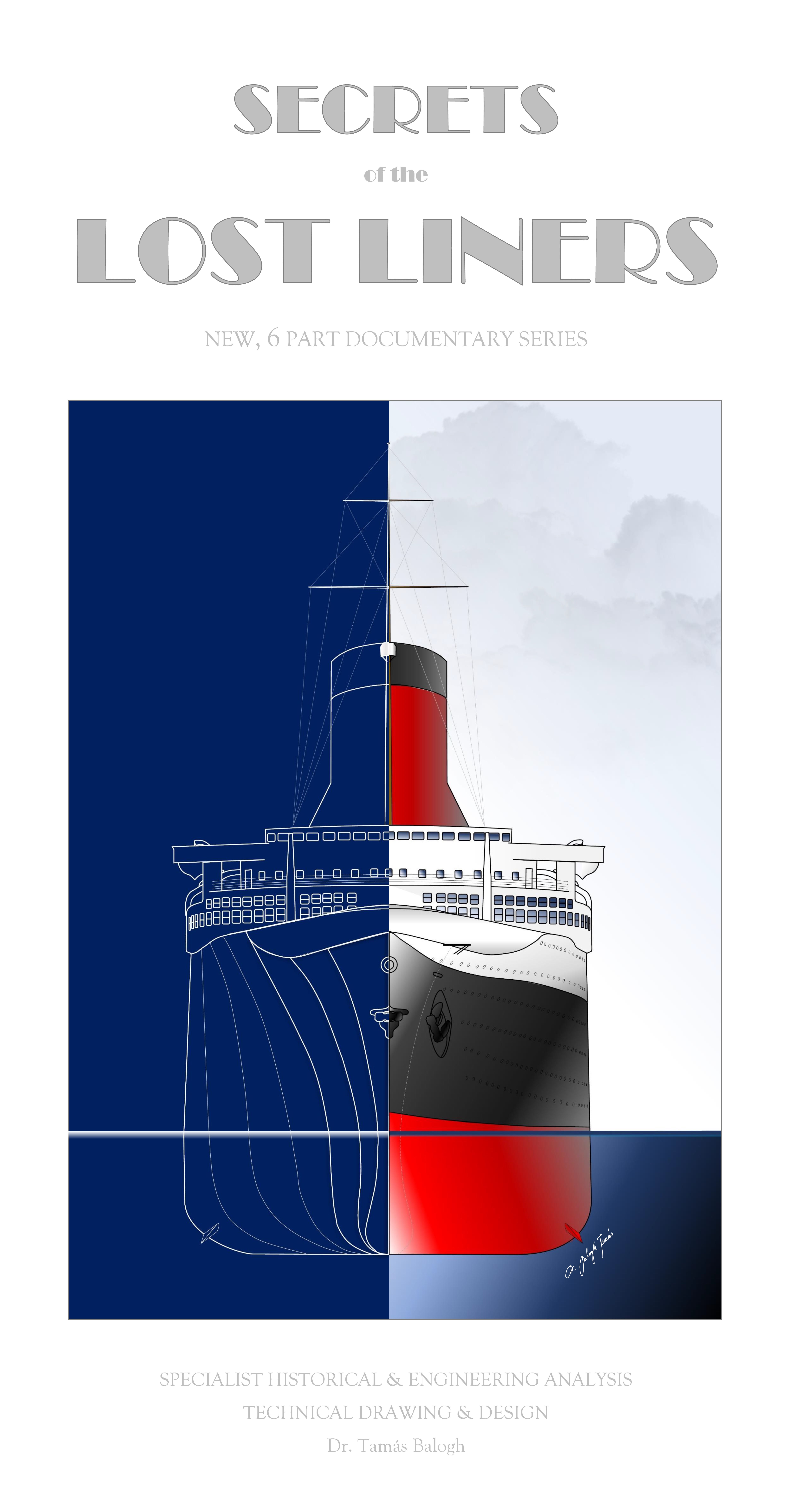
A közös munka végén Max Barber elismerő hangú referencia-levéllel ismerte el a munka minőségét, ami külön is visszaigazolta a projektben való részvétel menet közben is mindvégig átérzett örömét:
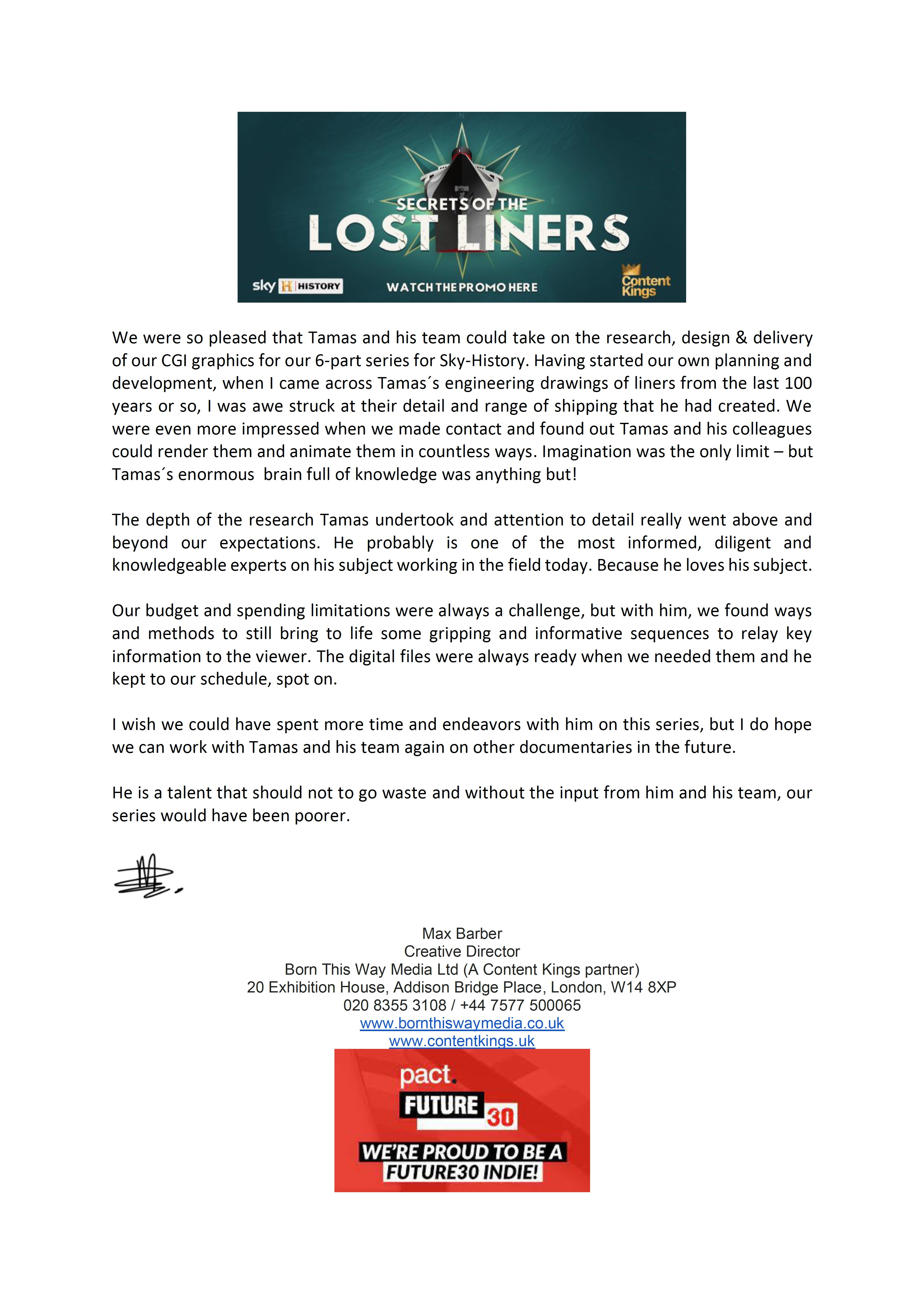
"Elveszett óceánjárók titkaiNagyon örültünk, hogy Tamás és csapata felvállalhatta a Sky-History részére forgatott 6 részes dokumentumfilm-sorozatunkhoz készített CGI grafikáink elkészítéséhez szükséges kutatás, tervezés és szállítás feladatát. Már elkezdtük a saját tervező munkát és fejlesztést, amikor találkoztam Tamásnak az elmúlt 100 évben épült óceánjárókról készített műszaki rajzaival, s lenyűgözött az általa készített ábrázolás részletessége és a hajózás történetének általa lefedett széles köre. Még jobban lenyűgözött bennünket, amikor felvettük a kapcsolatot, és rájöttünk, hogy Tamás és kollégái számtalan módon tudják renderelni és animálni ezeket a rajzokat. Csak a képzelet szabhatott határt – de Tamás hatalmas tudással teli agyára tekintettel tulajdonképpen még az sem!
A Tamás által végzett kutatás mélysége és a részletekre való odafigyelés valóban felülmúlta a várakozásainkat. Valószínűleg ő az egyik legtájékozottabb, legszorgalmasabb és leginkább hozzáértő szakértő a témában napjainkban. Mert szereti a témát.
Költségkeretünk és költekezésünk korlátai mindig is kihívást jelentettek, de vele együtt módokat és módszereket találtunk arra, hogy mégis életre keltsünk néhány lebilincselő és informatív szekvenciát, amellyel kulcsfontosságú információkat juttathatunk el a nézőhöz. A digitális fájlok mindig készen voltak, amikor szükségünk volt rájuk, és ő pontosan tartotta magát az ütemtervünkhöz.
Bárcsak több időt tölthettünk és több erőfeszítést tehettünk volna vele együtt ezen a sorozaton, illetve sorozatért, de remélem, hogy a jövőben más dokumentumfilmeken is együtt dolgozhatunk Tamással és csapatával.
Ő egy olyan tehetség, akit nem szabad elveszíteni, s az ő és csapata közreműködése nélkül a sorozatunk szegényebb lett volna.
Max Barber
kreatív igazgató"
Nagyszerű, ha tetszik a cikk és a benne megosztott képek. Ha érdeklik a szerző munkái, az Encyclopedia of Ocean Liners Fb-oldalán találhat további információkat a szerzőről és munkásságáról.A képek megosztása esetén, a bejegyzésben mindig tüntesse fel az alkotó nevét. Köszönöm!
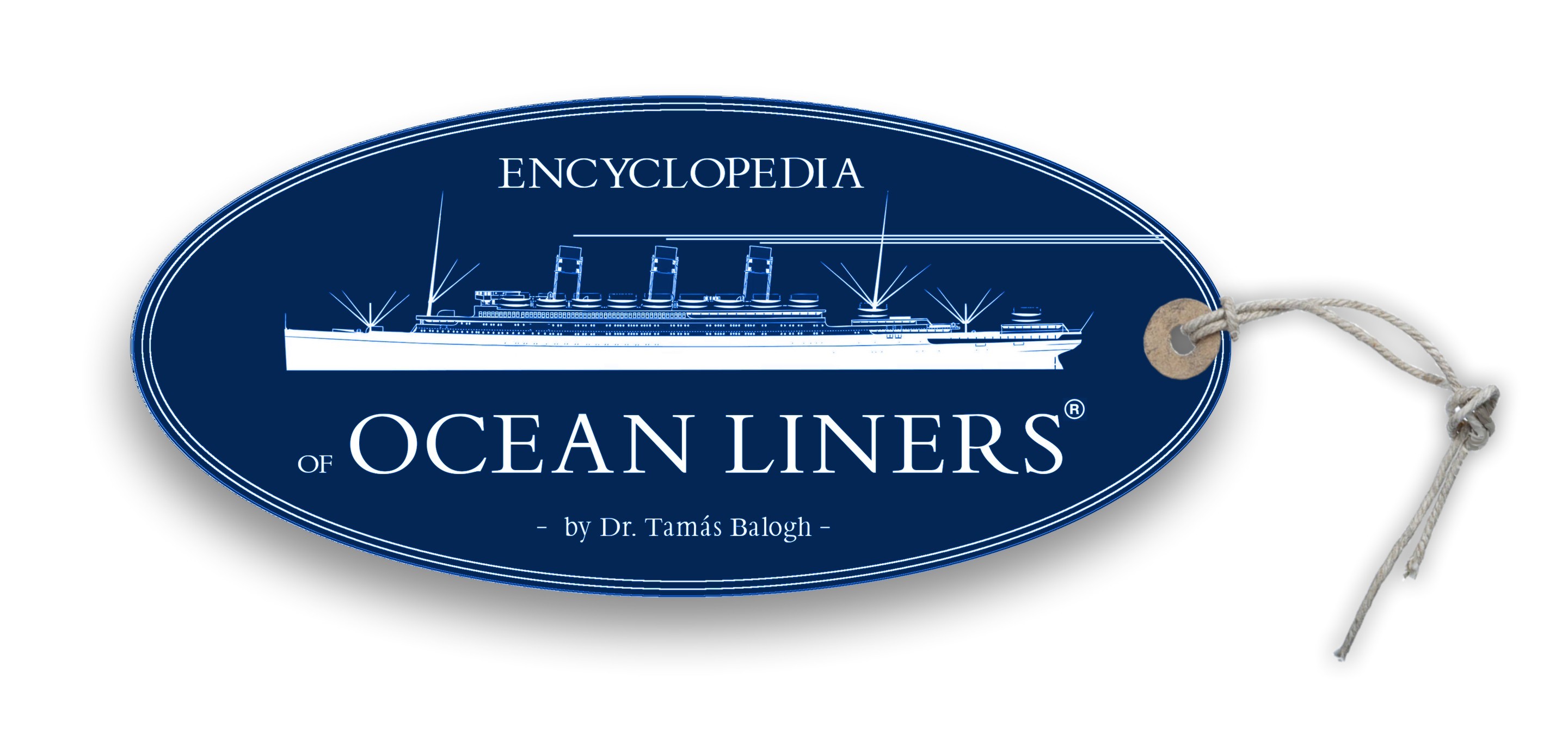
-
A H.M.T. JUSTICIA (ex-STATENDAM II.) kronológiája
2018-ban jelent meg egyesültünk elnökének könyve a holland megrendelésre a TITANIC tervei alapján épült óceánjáró, a STATENDAM (II). történetéről, amely az első világháborúban JUSTICIA néven brit lobogó alatt teljesített szolgálatot és süllyedt el 1918-ban, mindössze négy hónappal a háború vége előtt. A könyv megjelenése óta eladott példányok olvasói folyamatos visszajelzésekkel járulnak hozzá ahhoz, hogy a szerző is megismerhesse, milyen hatást keltett a százéves történet modern feldolgozása. Ezek a visszajelzések a szerző FB-oldalán az „Olvasósarok” rovatban bárki által megismerhetők. A legfrissebb visszajelzést az angliai Kentben élő Myles Chantler küldte: „Csak annyit mondanék: a JUSTICIA-ról/STATENDAM-ról írott könyve első osztályú. Lenyűgöző könyv, a hajóról szóló megannyi információval! Épp befejeztem az olvasását, és most kezdem elölről, nehogy kihagyjak bármit is! Feltehetnék ugyanakkor egy kérdést? Vajon rendelkezésre áll-e időrendi lista a hajó háborús útjairól? Jó lenne tudni, hogy hány alkalommal és mely kikötőket érintette a hajó. […] Még egyszer köszönöm a remek könyvet!” Nos, a JUSTICIA történetének kronológiája eddig még nem készült el. A kérdés nyomán azonban Balogh Tamás most elkészítette, hiszen a Szerző számára is kivételes öröm, ha az Olvasó pozitív visszajelzése nyomán tovább folytatódhat a történet.
1912.03.01.: Johann Georg Reuchlin, a rotterdami székhelyű Holland-America Line vezérigazgatója megrendeli a hajót a belfasti Harland & Wolff Hajógyártól. A hajó terveit az előző évben nagy sikert arató OLYMPIC-osztályú óceánjárók tervei alapján készítik el, de a hajó három hajócsavarja közül a középső az OLYMPIC-on alkalmazott megoldástól eltérően – a TITANIC-on követett és a korábban már bevált megoldással megegyező módon –nem négy-, hanem csak háromszárnyú.
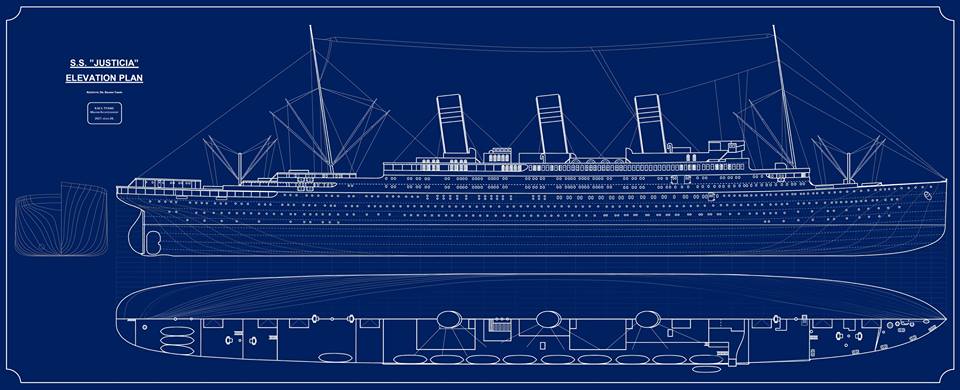
1. ábra: A hajó tervei, felülnézete és vonalterve (Forrás: Dr. Balogh Tamás).
1912.03.21.: Joseph Bruce Ismay, az International Mercantile Marine vezérigazgatója a vállaltcsoporthoz tartozó tagvállalatok vezetői közt Johann Georg Reuchlin-t is meghívja a White Star Line legújabb óceánjárója, a TITANIC avató útjára.
1912.04.15.: A TITANIC elsüllyedése, Johann Georg Reuchlin halála. A hajó annyira hasonlít a TITANIC-hoz, hogy az elsüllyedt óceánjáró katasztrófájának megfestéséhez William Henry Pearson a STATENDAM-ot használja fel modellként, amint az a festményen ábrázolt hajó felépítményének elejéről egyértelműen azonosítható.
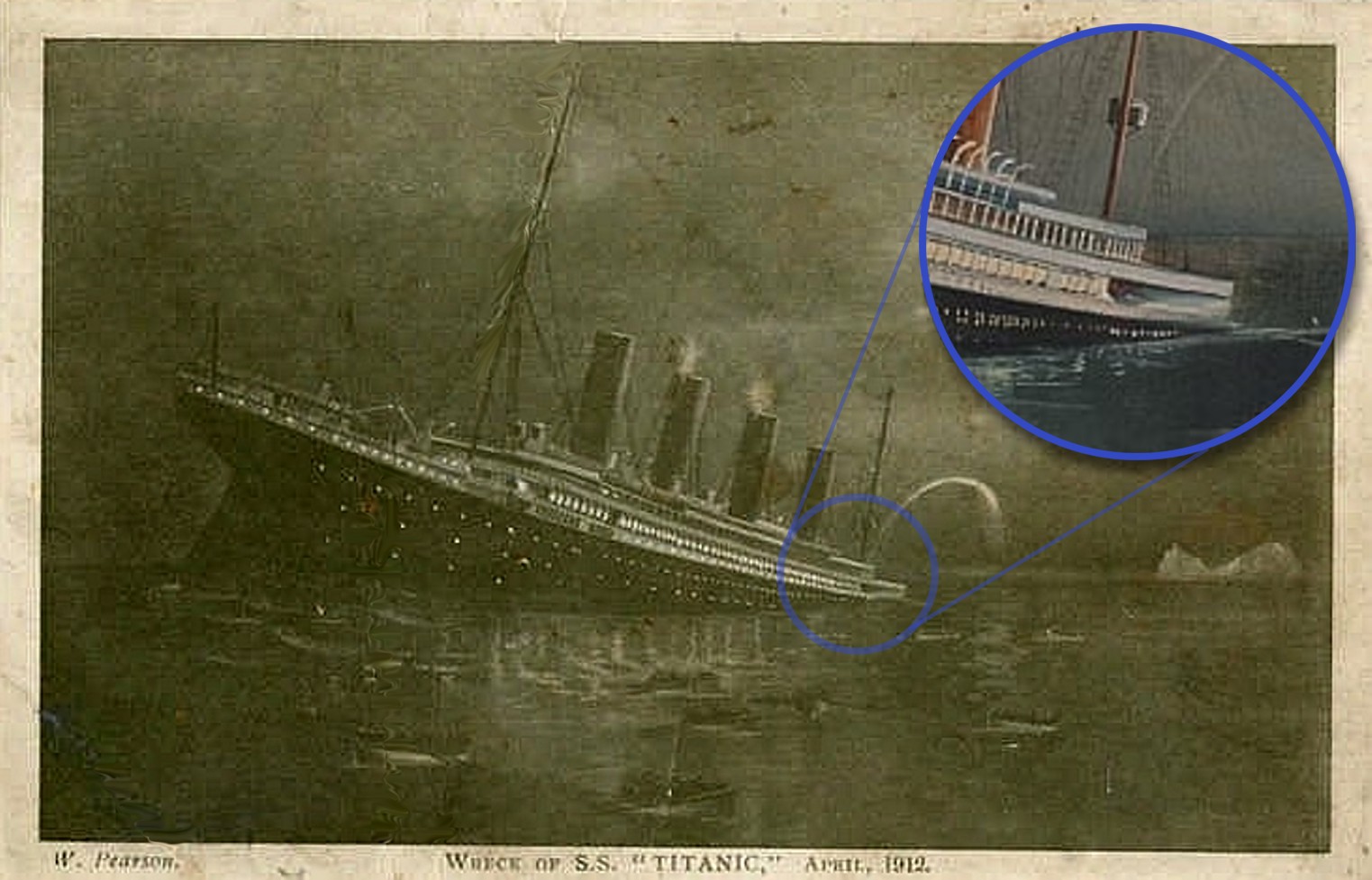
2. ábra: Fekete-fehér reprodukció a Pearson-festményről és annak az a részlete, amely a STATENDAM általános elrendezését követi, nem pedig a TITANIC-ét (Forrás: Greenwichi Királyi Múzeum).
1912.05.31.: A tervezés alatt álló hajó biztonsági rendszerének teljes áttervezése, a válaszfalak felmagasítása.

3. ábra: A hajó újratervezett vízzáró válaszfalai. A TITANIC süllyedésével kapcsolatos vizsgálat eredményeként végrehajtott módosítások piros tintával jól láthatók a rajzon (Forrás: Lloyd's Register Alapítvány, Örökségi és Oktatási Központ).
1912.07.11.: A hajó gerincfektetése (yard no. 436.).
1914.07.09.: A hajó vízrebocsátása.
1914.07.28.: Az első világháború kitörése.
1914.08.04.: Nagy-Britannia belép az első világháborúba.
1914.10.01.: A brit admiralitás felfigyel a nagy befogadóképességű, gyors és félkész hajóra, és 1 000 000 fontot ajánl a berendezések nélküli hajótestért a Holland-America Line-nak. A cég azonban szeretné megtartani a hajót, ezért felajánlja, hogy inkább mérsékelt díj ellenében bérbe adja, ha a háború után visszakaphatja, vagy az Admiralitás hasonlót biztosít, ha a hajó odaveszne a harcokban. Nem születik megegyezés, de a tárgyalások folytatódnak.
1915.03.02.-1915.12.04. között a San Franciscóban megrendezett Panama-Csendes-óceáni Világkiállításon bemutatták a hajó fényes belső tereit díszítő berendezés egy részét. A kiállítás elvben az 1914 augusztusában átadott Panama-csatorna megnyitását volt hivatva ünnepelni, valójában a rendező San Francisco kívánt demonstrálni, hogy kiheverte az 1906-os pusztító földrengés hatásait (további információ: https://www.worthpoint.com/worthopedia/ss-statendam-holland-america-line-165787502).
1915.09.01.: A hajó sorsát illető tárgyalások lezárulnak. A brit admiralitás elfogadja a holland feltételeket.
1915.12.08.: A szerződés aláírása és a hajó átadása a brit Királyi Haditengerészet számára. Az Nemzetközi Kereskedelmi Tengerhajózási Társaság 10 %-os közvetítői jutalékot kap.
1917.04.07.: Az Egyesült Államok hadba lépését követő napon befejezik a hajó felszerelését és szolgálatba állítják, mint szállítóhajót. Eredetileg (a ténylegesen hadianyag-szállító hajóként használt „Lusitania” 1915. május 7-i német elsüllyesztése után) a kormánytámogatást élvező Cunard Line-nak ajánlották fel, ezért a STATENDAM nevet a Cunard "ia"-ra végződő névadási gyakorlata szerint (s a háborús propaganda részeként arra utalva, hogy így helyre-áll az „igazság”) JUSTICIA-ra változtatták és elé illesztették a H.M.T. (Hired Military Transport - Bérelt Katonai Szállítóhajó) rövidítést (sok forrás a H.M.H.T., His Majesty's Hired Transport - Őfelsége Bérelt Szállítóhajója, köznyelvi változatot használja). Ám a Cunard nem tudott elég embert, matrózt, gépészt és tisztet kiállítani, márpedig az Admiralitás feltételei szerint legénységről az üzembentartónak kellett gondoskodni. Mivel a flotta ragaszkodott a hajó mielőbbi szolgálatba állításához, nem vártak, amíg Cunard megoldást talál, hanem felajánlották a hajót a White Star Line-nak is, amely kapott az ajánlaton és az 1916. november 20-án elsüllyesztett Britannic túlélő legénységét vezényelte a hajóra (akik örültek, hogy megmarad a munkaviszonyuk). A hajó a Pireuszban felvett legénységgel a görögországi Lémnosz szigetére ment, ahonnan a Gallipoli hadjáratból evakuált brit katonákkal tért vissza Nagy-Britanniába. A hajó parancsnoka Alexander Elvin Sherwin Hambelton (1863-1929) (további információ: https://www.encyclopedia-titanica.org/community/threads/news-from-1922-1929-retirement-and-death-of-capt-hambelton.25501/; https://ancestors.familysearch.org/en/GQC6-FCQ/alexander-e.s.-hambelton-1863-1929).
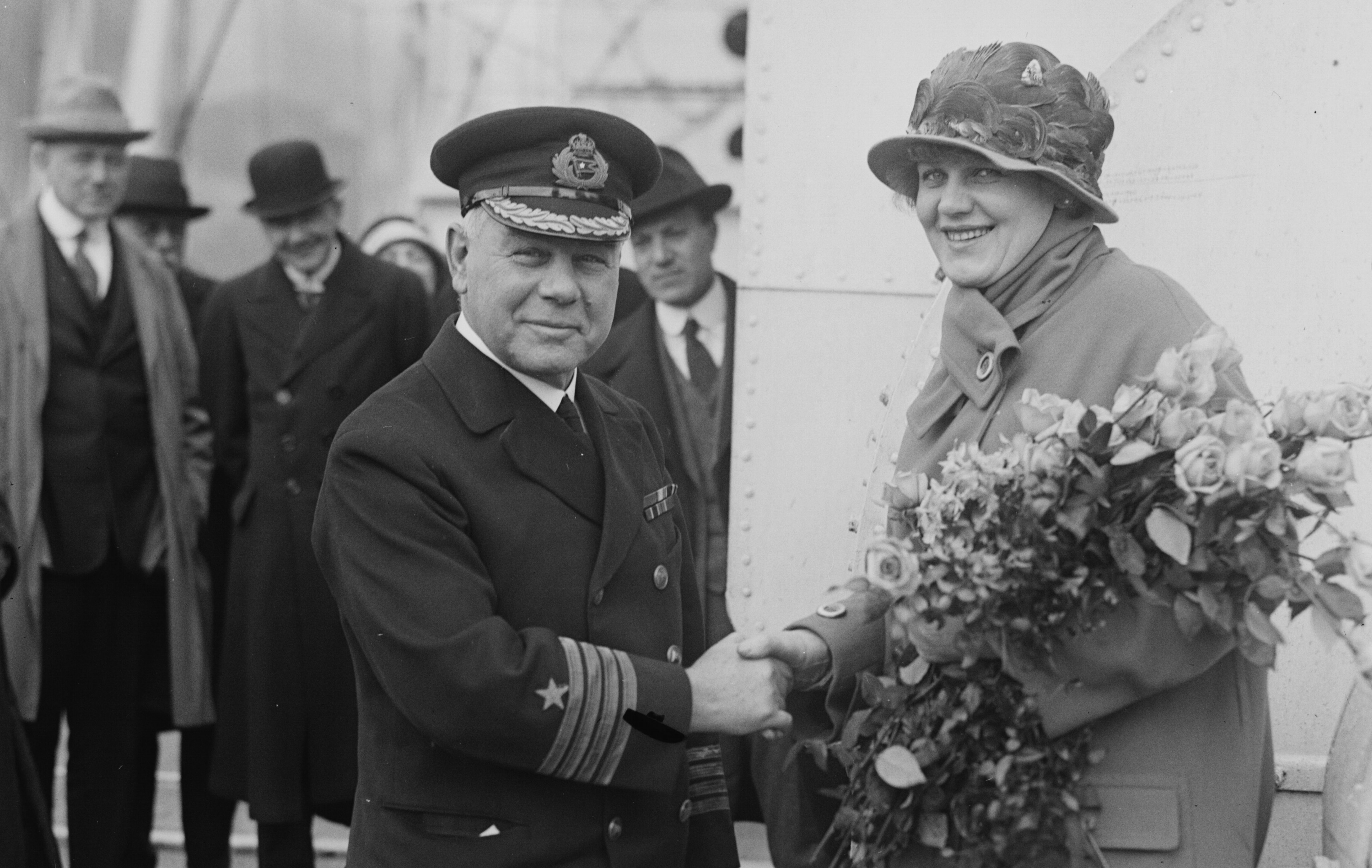
4. ábra: Alexander Elvin Sherwin Hambelton (1863-1929), a JUSTICIA parancsnoka (Forrás: Wikimedia Commons).
1917.04.25.: A JUSTICIA a White Star Line másik óceánjárója, az Adriatic társaságában első atlanti átkelésén New York-ba érkezik. Ettől kezdve rendszeresen ingázott Liverpool és a kanadai Halifax, valamint az amerikai New York között. Járatain átlagosan 5 000 katonát és 15 000 tonnányi felszerelést szállít.
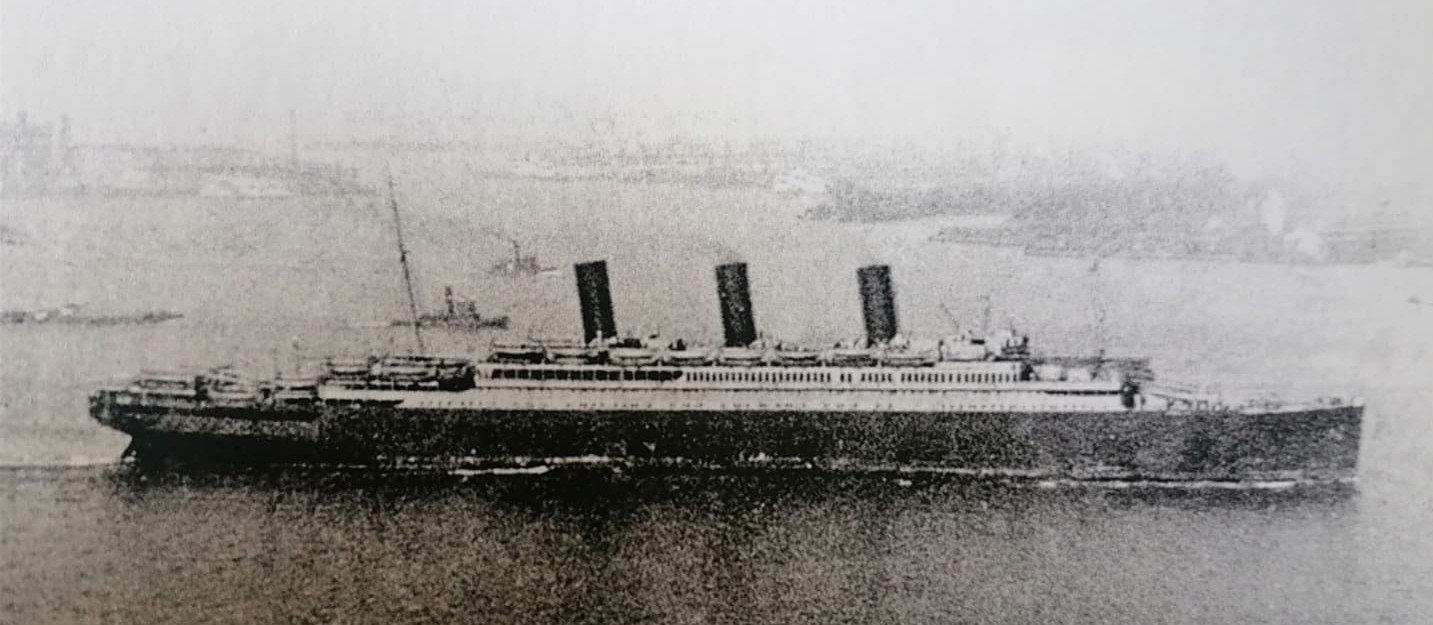
5. ábra: A hajó a New York-i kikötőben. Balra a háttérben az Ellis-sziget épületei láthatók. A hajó maga - a kémények kivételével - az eredeti színeit viseli (Forrás: egy holland gyűjtő gyűjteményéből, pontos referencia szükséges).
1917.06.14.: A brit admiralitás egy éves előkészítés és több gyakorlati próba után bevezeti a kereskedelmi hajók konvojrendszerét az Atlanti-óceánon (a Földközi-tengeren 07.22-én). 1917-ben 189 Nagy-Britanniába tartó (2 825 hajóval), illetve 164 Nagy-Britanniából induló konvoj (2 365 hajóval), 1918-ban pedig 417-373 konvoj (6 866-5 126 hajóval) kelt át az Atlanti-óceánon.
1917.10.23.: A hajó a Halifaxból indult konvojjal Liverpoolba érkezik. A hajón ezúttal összesen 1 494 személy – 1 391 katona (1 075 amerikai, 101 kanadai és 213 szerb tartalékos), valamint 105 külföldi utas – tartózkodott. Az utas-listán 7 brit alattvaló polgári személy neve is szerepelt (valamennyien nők), 6-an a fedélzeten szállított sereg tisztjeinek feleségei (egyikük Sir Charles McGrigor dandártábornok hitvese), egyikük pedig a Montreali Bank vezérigazgatójának felesége.
1917.12.06.: A hajó a Halifaxból kifutó konvojjal Liverpoolba indul. Ezen az útján megdönti az első világháborús tengeri hadiszállítások rekordját: 30 000 tonna hadianyagot (a háborúban addig hajón szállított legnagyobb mennyiséget) és a front mögötti munkára toborzott 12 000 kínai munkást szállít a fedélzetén. A hajó kifutása csaknem egybeesett a városban történt hatalmas lőszerrobbanással, amikor a 2 300 t pikrinsavval, 200 t TNT-vel, 35 t magas oktánszámú benzinnel és 10 t lőgyapottal megrakott Mont Blanc, francia teherszállító hajónak a kikötőben nekiütközött a rakomány nélkül közlekedő norvég Imo teherhajó (amely eredetileg Runic néven épült Belfastban a White Star Line részére 1889-ben). A Mont Blanc az ütközés után 10 perccel kigyulladt és 25 perccel később felrobbant. A hajó körül 2 km2-es körzetben minden épület elpusztult, s 1 950 ember meghalt, több mint 9 000-en megsebesültek. A 3 kilótonna erejű robbanás – amely az ember által előidézett legnagyobb nem nukleáris robbanás – szökőárat okozott a kikötőben, a nyomáshullám fákat és oszlopokat csavart ki, épületeket pusztított el és hajókat rongált meg. A Mont Blanc darabjai 6 km-es körzetben szóródtak szét (később a hajó egyik több tonnás horgonyát 4, a fedélzeten lévő 90 mm-es ágyú maradványait pedig 6 km-re találták meg). Két napig az a szóbeszéd járta, hogy a JUSTICIA is a megsérült hajók között van (sőt, a robbanás hatalmas ereje miatt sokan úgy gondolták, hogy eleve a JUSTICIA fedélzetén szállított 30 000 tonna hadianyag robbant fel), míg kiderült, hogy a Mont Blanc ütközése előtt néhány órával korábban elhagyta a kikötőt…
1918.01. … : A hajótest addig egységes szürke színét az előző év októberében kikísérletezett geometrikus álcázó festéssel látták el.
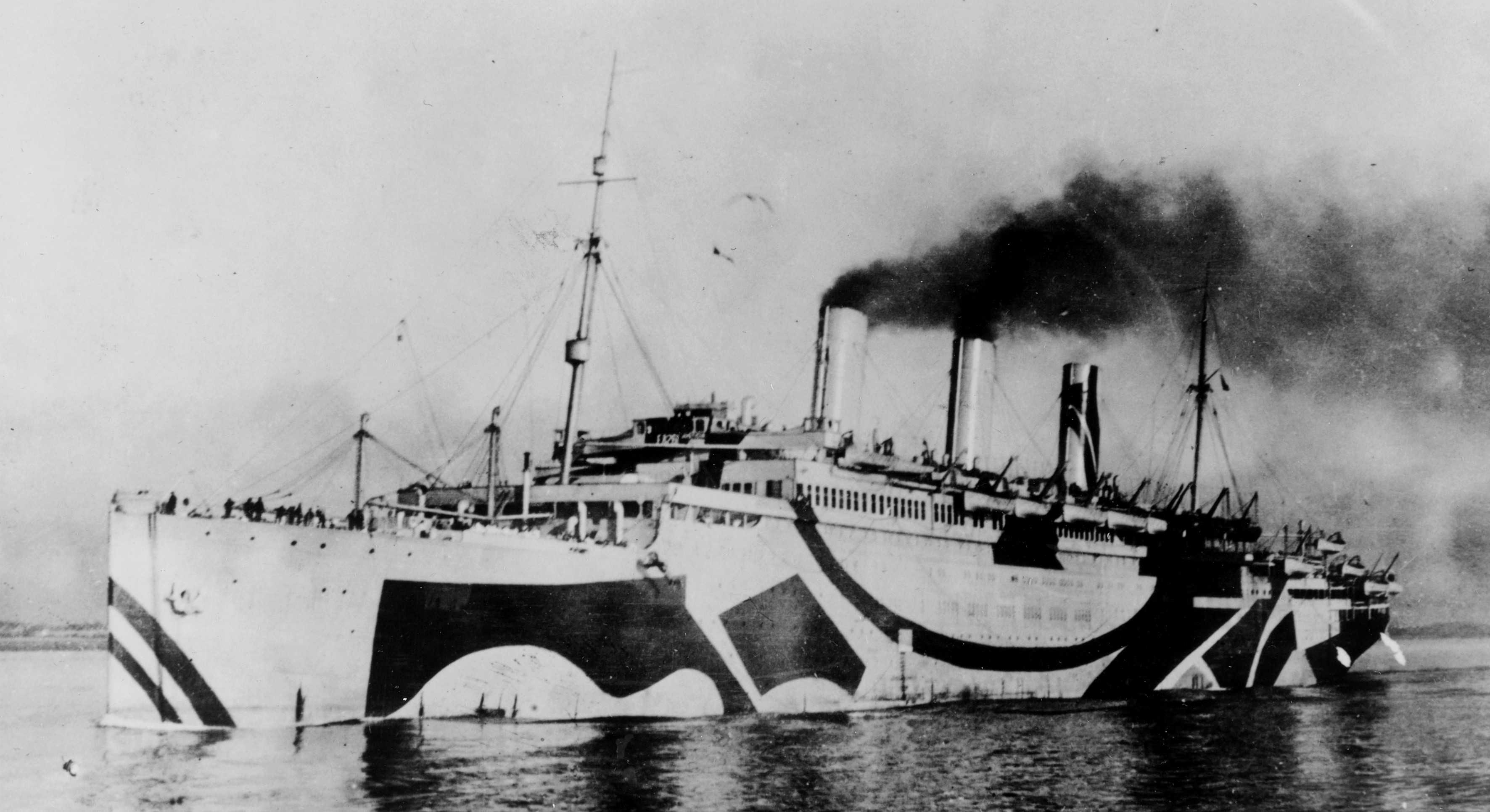
6. ábra: A hajó szemkápráztató álcázó festése (Forrás: Naval History and Heritage Command, NH 101616).
1918.01.24.: A hajó a New York-ból indult konvojjal Halifax érintésével Liverpoolba érkezik. Egy nappal korábban, a Szent György-csatornában került sor a hajó elleni első – ekkor még sikertelen – torpedótámadásra.
1918.04.19.: A hajó a New York-ból indult konvojjal Liverpoolba érkezik.
1918.05.31.: A hajó a New York-ból indult konvojjal Liverpoolba érkezik.
1918.06.27.: A JUSTICIA kifutott New Yorkból Liverpool felé, 5 000 katonával a fedélzetén. Ez volt az utolsó alkalom, hogy a hajó New Yorkban járt, s Európában Hambelton kapitány is kiszállt. A hajónak erről az átkeléséről a fedélzeten szállított 301-es műszaki alakulat 1920-ban kiadott csapat-történetében is megemlékeztek (a kötet 52-58. oldalán). A parancsokságot Hugh F. David vette át.
1918.07.19.: Hajnali 01:10-kor a JUSTICIA ismét Liverpoolból New Yorkba indul (alig négy hónappal a fegyverszünet előtt). Az OLX 39 jelű gyors konvojt a JUSTICIA és hat másik kereskedelmi hajó – köztük a Melita, Mategama és a Lapland óceánjárók – valamint hat romboló alkotja.
14:30-kor az Otto Schrader tengerész főhadnagy parancsnoksága alatt haladó U64-es partvédő tengeralattjáró két torpedót lőtt ki a hajóra, alig 23 mérföldre (42,6 km-re) a Skerryvore zátonytól. Schrader összetévesztette a hasonló sziluettű USS LEVIATHAN-nal (ex-VATERLAND), a németektől lefoglalt amerikai óceánjáróval (amely a háború legnagyobb kapacitású csapatszállítója volt, s amelyet minden német tengeralattjárós el akart süllyeszteni). Az egyik torpedó elvétette a célt, a másik azonban a JUSTICIA gépházában robbant, a menetirány szerinti baloldalon. A gépház csakhamar megtelt vízzel és a hajó mozgásképtelenné vált, az állapotát mindazonáltal sikerült stabilizálni. David parancsnok ezért felkészült rá, hogy a haditengerészet SONIA nevű vontatója partközelbe, a 16 órányi útra fekvő buncranai sürgősségi tengerészeti javítóbázisra vontassa.
16:30-kor – a vontatási művelet előkészítése közben – azonban Schrader kilőtt két újabb torpedót. Egyikük célt tévesztett, a másikat pedig a JUSTICIA fedélzeti ágyúi semmisítették meg, még a célba érkezés előtt.
20:00-kor az U64-es újabb torpedót indít, amelyet ezúttal is a JUSTICIA tüzérei semlegesítenek.
21:00-kor a naplemente előtt 20 perccel evakuálják a JUSTICIA személyzetét (mivel egy éjszakai torpedótámadás során a sikeres mentés esélye jóval kisebb), a sérült hajón a vontatás idejére csak 16 főnyi önkéntes személyzet marad a legszükségesebb feladatok ellátására. A JUSTICIA-t kísérő rombolók elhárító műveleteiben megsérült U64-es rádión riadóztatja a közelben haladó többi német tengeralattjárót. Hívására az U54-es (Hellmuth von Rückteschell) és az U124-es (Hans Oscar Wutsdorff) tengeralattjárók válaszoltak.
1918.07.20.: Hajnali 04:30-kor a kötelék 28 mérföldre (45 km-re) járt a parttól (ezzel az előző napi 11 órás küzdelemmel a partig hátralévő táv több, mint felét ledolgozták, tudva, hogy még három óra, és a part látótávolságába érnek, újabb három óra elteltével pedig már biztonságban vannak). Az U124-es egy torpedót lő ki a hajóra, amely azonban célt téveszt.
06:00 óra körül további brit erősítés érkezik: már 12 romboló és 14 egyéb őrhajó biztosítja a sebesült óriást.
09:15-kor az U124-es újabb két torpedót indít (a hajóra kilőtt hetedik és nyolcadik torpedó): az első a kazánházak előtti 3-as, a második pedig a főárboc alatti 5-ös számú üres raktérbe csapódott. Ezzel – a pénteki támadások eredményével együtt – a hajó 11 vízhatlan rekesze közül 4 helyrehozhatatlanul víz alá került.
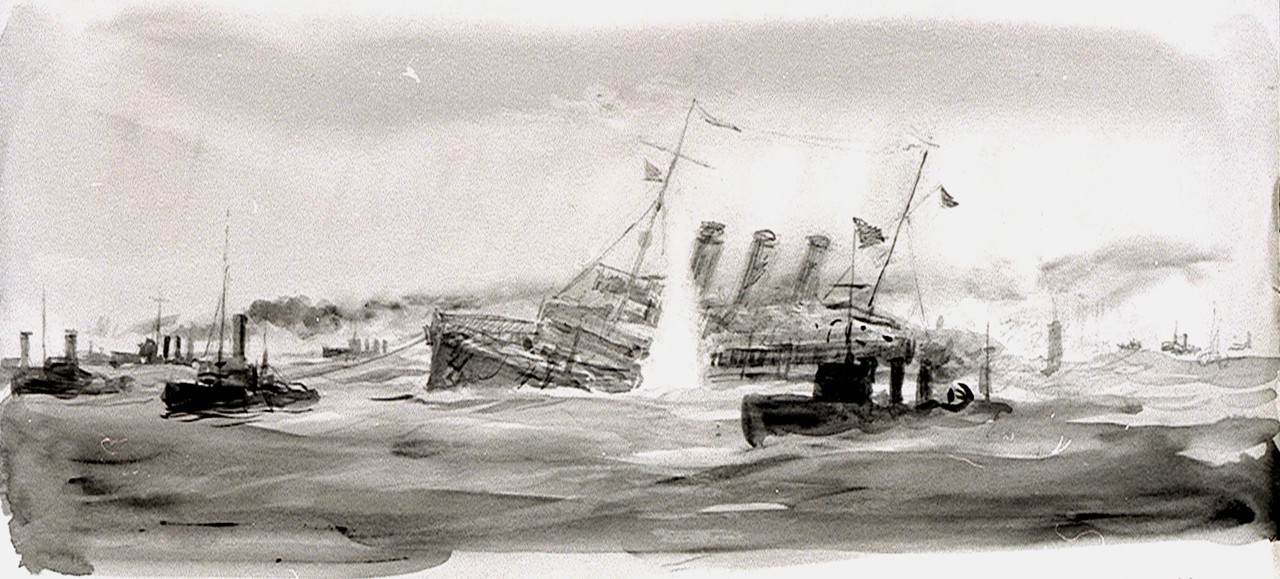
7. ábra: A JUSTICIA 24 órás küzdelmének művészi ábrázolása William Lionel Wyllie akvarelljén (Forrás: Wikimedia Commons).
10:30-kor a 16 fős szükség-legénység elhagyja a hajót, amelyet a SONIA mintegy 6 csomós sebességgel még ezután is vontat, készen arra, hogy elengedje, ha rosszabbra fordulna a helyzet.
11:32-kor a frissen a helyszínre érkező U54-es tengeralattjáró két torpedót indít a JUSTICIA irányába. Mindkét torpedó még a célba érés előtt felrobban.
12:30-kor a vízzel egyre jobban megtelő hajó tatja végleg a víz alá merül, s alig tíz perccel később az egész hajó elsüllyed. Pozíció 55° 38’ észak, 07° 39’ nyugat.
19:00 órakor az U124-est elsüllyesztik a JUSTICIA kísérő rombolói, az HMS MILBROOKE és az HMS PIGEON.
A JUSTICIA elsüllyedésének 10 áldozata volt. Az első torpedó robbanása azonnal megölt 9 embert és halálosan megsebesítette James Thomas harmadik géptisztet, aki másnap reggel belehalt a sérüléseibe. A halottak között volt Christopher Foran raktáros, Percy Grant tűzoltó, James O’Neil, Thomas Russel és John W. Sutton olajozó, Maurice Johnston, Samuel J. Turner, David Watt fűtő és William J. Jones szénhordó. Az U124-es legénységéből életét vesztette Karl Engstfeld fedélzeti mérnök és Paul Seevers tengerész-hadnagy.
A JUSTICIA – mint a háborúban a Lusitania (1915) és a Britannic (1916) után elsüllyesztett harmadik legnagyobb kereskedelmi hajó – elvesztéséről az óceán mindkét partján hírt adott a sajtó, kiemelve, hogy (a háború folyamán először) tengeralattjárók egész falkája hajtott végre összehangolt támadást a célba vett hajó ellen.
Az esetet hivatalos vizsgálat követte, amely feltárta a transzóceáni konvojok hadihajó-kíséretének gyengeségeit.
Az óceánjáró és a tengeralattjárók egyenlőtlen küzdelmét a kor híres angol tengerészeti festője, William Lionel Wyllie is megörökítette.
1919.01.29.: A brit kormány a hajó bérbevételéről kötött 1915. december 8-i megállapodásnak megfelelően 60 000 tonna acélt biztosít a holland kormány számára egy új óceánjáró felépítéséhez. A Holland-America Line megrendeli az új óceánjárót a Harland & Wolff Hajógyártól. Mivel az Egyesült Államok 1922-1924 között drasztikusan szűkítette a bevándorlási lehetőségeket, az óceáni utasforgalom is átalakult, ezért a STATENDAM III. az elődjénél valamivel kisebb lett, gyári modellje alapján azonban látható, hogy a hajó így is egyértelműen a STATENDAM II. formakincsének folytatója. (A hajó építése a sorozatos sztrájkok miatt 1924-1927 között leállt, végül félkész állapotban átvontatták Hollandiába, ahol 1929-re fejezték be a felszerelését. A két világháború közti időszak legnépszerűbb holland óceánjárója 1940. május 11-én, a Rotterdam elleni német támadásokban pusztult el. Emlékét ma már csak a róla készült és fennmaradt számtalan korabeli fényképfelvétel őrzi.)

8. ábra: A STATENDAM II. (fent) és III. (lent) gyári modelljei a Harland & Wolff Hajógyárból (Forrás: Tengerészeti Múzeum, Rotterdam).
1993.: Norman és Simon Bamford búvárok megtalálják, merülik és azonosítják a JUSTICIA roncsát.
1995.: Leight Bishop ismert víz alatti fotós, roncsbúvár impresszív víz alatti fotókat készít a roncsokról, amelyek búvárok százait vonzzák és jelentősen hozzájárulnak a roncs ismertté tételéhez.
2005: Az Ír Országos Tengerfenék-felmérés keretében elkészül a roncsok első SONAR-képe.
2014: Norman Woods búvárnak elsőként sikerül a roncsmező nagyobb területeit összefüggően bemutató víz alatti filmfelvételt készítenie úgy, hogy GoPro kameráját a búvárvontatójához rögzítette, így 13 perc alatt képes volt oda-vissza végigúszni a hatalmas hajó hossztengelye mentén.
2018: Balogh Tamás elkészíti a JUSTICIA történetének és roncsainak első monografikus feldolgozását, amelyet a hajó elsüllyedésének századik évfordulóján a hajó szülőhelyén, a belfasti Harland és Wolff Hajógyárban mutattak be a nyilvánosságnak. Darragh Norton búvár és víz alatti fotós vezetésével centenáriumi búvárexpedíció emlékezik meg a hajó elsüllyesztéséről.
2019: Barry McGill búvár azonosítja az U124 roncsait. Matt Bone rendezésében, Barry McGill és Balogh Tamás szakértői közreműködésével elkészül a JUSTICIA történetét és roncsait bemutató első dokmentumfilm.
2020: Gerard Dooly, az írországi Limerick Egyetem kutatója, egyben az Egyetem Mobil és Tengeri Robotikai Kutatóközpontjának munkatársa kezdeményezte a legújabb generációs eszközök (víz alatti szkennerek és a kiterjesztett valóság) felhasználását a hajóroncs kutatásának támogatására.
2021: Balogh Tamás tervei alapján Gyurik Bennett elkészítette a hajó első virtuális rekonstrukcióját, amelyet a KGB Stúdió munkatársai egy 20 másodperces animációba illesztettek be.
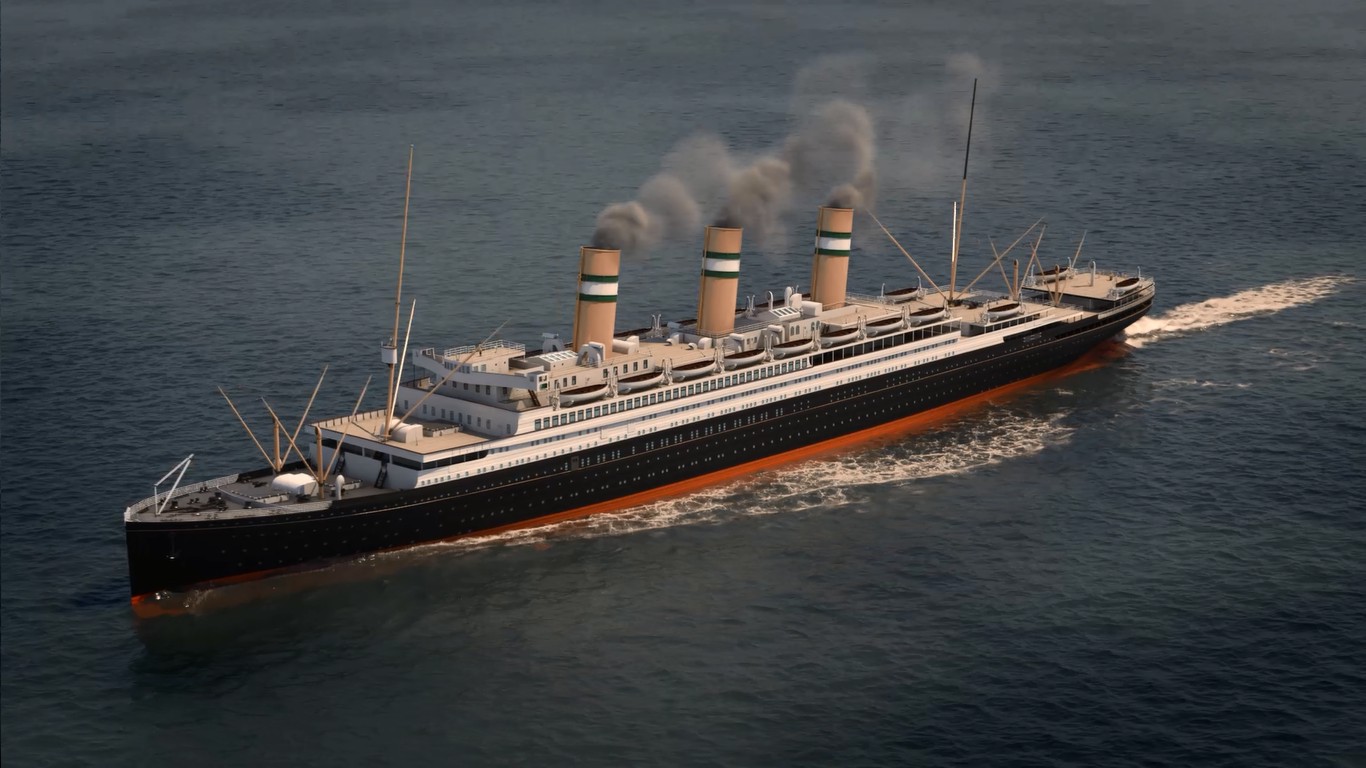
9. ábra: A hajó modern 3D-s megjelenítése (Forrás: Dr. Balogh Tamás gyűjteménye).
Nagyszerű, ha tetszik a cikk és a benne megosztott képek. Ha érdeklik a szerző munkái, az Encyclopedia of Ocean Liners Fb-oldalán találhat további információkat a szerzőről és munkásságáról.
A képek megosztása esetén, a bejegyzésben mindig tüntesse fel az alkotó nevét. Köszönöm!

-
Chronology of the H.M.T. JUSTICIA (ex-STATENDAM II.)
President of our Association published his book in 2018 on the the ocean liner s.s. STATENDAM (II), which designed following the TITANIC, ordered by the Netherlands, served under the British flag as H.M.T. JUSTICIA and sank in 1918, just four months before the end of the war. Readers of the copies sold since the publication of the book provide ongoing feedback to help the author learn about the impact of modern interpretation of the hundred-year-old story. These feedbacks can be read by anyone in the “Reader's Corner” section of the author’s Facebook-page. The latest feedback was sent by Myles Chantler, who lives in Kent, England: “Just wanted to quickly message to say your book on the Statendam / Justicia is first class. What a stunning book and so much information about the ship! I've just finished reading it, and I am starting again from the beginning incase I have missed anything! Could I ask a couple of questions if I may? Have you a chronological list of her war voyages. It would be lovely to know how many voyages were sailed, and to / from which ports. [...] Once again, thanks for a great book.” Well, the chronology of the JUSTICIA's life did not compiled yet. However, following the question, Tamás Balogh has now prepared it, as it is an exceptional pleasure for the Author to be able to continue the story following the positive feedback of the Reader.
01.03.1912: Johann Georg Reuchlin, CEO of Rotterdam-based Holland-America Line, orders the ship from Harland & Wolff Shipyard in Belfast. The ship's plans are based on the plans of the OLYMPIC-class ocean liners, which proved to be very successful one year earlier, but the propeller-arrangement differs from that introduced on the OLYMPIC, regarding the central propeller was only three-bladed instead of four (as in case of the TITANIC).

Figure 1: Elevation plans, top view and lines plan of the ship (Source: Dr. Tamás Balogh).
21.03.1912: Joseph Bruce Ismay, CEO of International Mercantile Marine, invites Johann Georg Reuchlin among the leaders of the member companies of the group, to the inaugural voyage of White Star Line's newest ocean liner, TITANIC.
15.04.1912: The sinking of the TITANIC, and the death of Johann Georg Reuchlin. The ship is so similar to TITANIC that the artist William Henry Pearson uses STATENDAM as a model to demonstrate the sinking ocean liner, as it could be clearly identified from the forward end of the ship’s superstructure depicted in the painting.

Figure 2.: Black and white reproduction of the Pearson's painting and it's characteristic detail which is based on the general arrangement of the STATENDAM rather than TITANIC (Source: Royal Museums of Greenwich).
31.05.1912: Complete redesign of the ship security system, including raising of bulkheads.

Figure 3.: The ship’s redrawn watertight bulkheads. Modifications made as a result of the inquiry on TITANIC's sinking can be clearly seen with red ink on the drawing (Source: Lloyd's Register Foundation Heritage and Education Center).
11.07.1912: Laying of the ship's keel (yard no. 436.).
09.07.1914: Launch of the ship.
28.07.1914: The outbreak of the First World War.
04.08.1914: Great Britain enters World War I.
01.10.1914: The British Admiralty interested in the high-capacity and fast but semi-finished ship and offers £ 1,000,000 for the hull to Holland-America Line. However, the company wants to keep the ship, so it offers to rent it out for a more moderate fee if the Admiralty give it back after the war, or will provide a similar one if the ship gets lost in enemy action. No agreement will be reached, but negotiations will continue.
02.03.1915 -04.12.1915. a part of the furnishing decorating the ship’s bright interiors was presented at the Panama-Pacific Exposition in San Francisco. The exhibition was basically meant to celebrate the opening of the Panama Canal, which was handed over in August 1914, but in fact San Francisco wanted to demonstrate it' own recovery from the effects of the devastating earthquake of 1906.
Further information:
http://digitized.library.fresnostate.edu/cdm/ref/collection/worldsfair/id/15114.01.09.1915: Negotiations on the ship's future are concluded. The British Admiralty accepts the Dutch conditions.
08.12.1915: Contract signed and the ship handed over to the British Royal Navy. The International Merchant Marine Co. receives a 10% brokerage commission.
07.04.1917: The day after the United States enters the war, the vessel is completed and put into service as a war transport ship. Originally she was offered to the government-subsidized Cunard Line as a replacement of the LUSITANIA sunk by a German U-boot in 1915, so the ship's name was changed from STATENDAM to JUSTICIA (names of all Cunard ships ended with “ia”) as the war propaganda suggests the ‘truth’ restored by this. But Cunard could not display enough hands, sailors, mechanics, and officers (under the conditions established by the Admiralty, all crew had to be provided by the operator). As the Government insisted on bringing the ship into service as soon as possible, they did not wait for Cunard to find a solution, but also offered the ship to the White Star Line, which accept the offer and redirected the surviving crew of the sunken Britannic lost in 1916 (all of them were happy to continue their employment). The ship, with its crew recruited in Piraeus, went to the island of Lemnos, Greece, from where she returned to Britain with British soldiers evacuated from the Gallipoli campaign. The ship's commander was Alexander Elvin Sherwin Hambelton. Further information: https://www.encyclopedia-titanica.org/community/threads/news-from-1922-1929-retirement-and-death-of-capt-hambelton.25501/; https://ancestors.familysearch.org/en/GQC6-FCQ/alexander-es-hambelton-1863-1929).

Figure 4.: Alexander Elvin Sherwin Hambelton (1863-1929), commander of the JUSTICIA (Source: Wikimedia Commons).
25.04.1917: JUSTICIA arrives in New York on her first Atlantic crossing together with ADRIATIC, another ocean liner of the White Star Line. From then on, she commuted regularly between Liverpool and Halifax, Canada, and New York, USA. She carries an average of 5,000 soldiers and 15,000 tons of equipment on its voyages.

Figure 5.: The ship in New York harbour. To the left in the background are the buildings of Ellis Island. The ship itself bears her original colors except the funnels (Source: courtesy of a Dutch collector, exact reference required).
14.06.1917: The British Admiralty, after a year of preparation and several practical trials, introduces a convoy system for merchant ships in the Atlantic Ocean (and on 22.02.1917. in the Mediterranean). In 1917, 189 convoys bound for Great Britain (with 2,825 ships) and 164 departing from Great Britain (with 2,365 ships), and in 1918, 417-373 convoys (with 6,866-5,126 ships) crossed the Atlantic.
23.10.1917: The ship arrives in Liverpool with a convoy from Halifax. This time, a total of 1,494 people were on board - 1,391 soldiers (1,075 US, 101 Canadian and 213 Serbian reservists) and 105 foreign passengers. The passenger list also included the names of 7 British subject (all women), 6 the wives of officers in the army carried on board (one of whom was the spouse of major-general Sir Charles McGrigor) and 1 the wife of the CEO of the Bank of Montreal.
06.12.1917: The ship departs for Liverpool with a convoy departing from Halifax. On this voyage, she breaks the record for World War I naval shipments: it carries on board 30,000 tons of war supply (the largest quantity ever transported by ship in the war) and 12,000 Chinese workers, recruited to work behind the front. The ship's departure almost coincided with a massive ammunition explosion in the city when the Norwegian cargo ship, IMO (ex-RUNIC of the White Star Line) collided with the freighter MONT BLANC, which loaded with 2,300 tonnes of picric acid, 200 tonnes of TNT, 35 tonnes of high-octane petrol and 10 tonnes of gunpowder. The MONT BLANC caught fire 10 minutes after the collision and exploded 25 minutes later. Within a 2 square-kilometer area of the ship, all buildings were destroyed, 1,950 people died and more than 9,000 were injured. The 3-kiloton explosion - the largest man-made non-nuclear explosion - caused a tsunami in the port, a pressure wave felled the trees and columns, destroyed buildings and damaged ships. Pieces of the MONT BLANC were scattered over a radius of 6 km (later one of the ship’s several-ton anchors was found 4 km, and the remains of a 90-mm cannon 6 km away). For two days, it was rumored that JUSTICIA was also among the damaged ships (in fact, due to the enormous power of the explosion, many thought 30,000 tons of munitions carried aboard JUSTICIA had exploded), until it was discovered that she left port a few hours before the MONT BLANC collided…
... 01.1918.: The ship's hull, which was uniform gray until that, was provided with a geometric dazzle-camouflage, tested in October of the previous year.

Figure 6.: The ship with dazzle camouflage (Source: Naval History and Heritage Command, NH 101616).
24.01.1918: The ship arrives in Liverpool by the convoy from New York, via Halifax. A day earlier, the first - then unsuccessful - torpedo attack against the ship had taken place in the St. George Canal.
19.04.1918: The ship arrives in Liverpool with a convoy departing from New York.
31.05.1918: The ship arrives in Liverpool with a convoy departing from New York.
27.06.1918: JUSTICIA sailed from New York to Liverpool with 5,000 soldiers on board. This was the last time when the ship had visited New York and Captain Hambelton had also disembarked in Europe. This crossing of the ship was also commemorated in the history of the 301th Engineers carried on board (pages 52-58 of the volume). The ship's command was taken over by Hugh F. David.
19.07.1918: At 1:10 a.m., JUSTICIA depart from Liverpool to New York again (barely four months before the armistice). The OLX 39 fast convoy consists of JUSTICIA and six other merchant vessels, including the MELITA, MATEGAMA and LAPLAND ocean liners, as well as six destroyers.
At 2:30 p.m., under the command of Lieutenant General Otto Schrader, the U64 coastal submarine fired two torpedoes at the ship, just 23 miles (42.6 km) from Skerryvore Rock. Schrader confused by the similar silhouette of the USS LEVIATHAN (ex-VATERLAND), an American ocean liner seized from the Germans (which was a high-capacity troop transporter for the war, and every German submarine wanted to sink it). One of the torpedoes missed the target, but the other exploded in the JUSTICIA's engine room, on the port side. The engine room soon filled with water and the ship became immobile, although her condition was stabilized by the damage-control crew. Commander David was prepared to tow by a Navy tug called SONIA to an emergency naval repair base in Buncrana, a 16-hour navigation away.
At 16:30, however, during the preparation for the towing operation, Schrader fired two more torpedoes. One of them was missed the target and the other was destroyed by JUSTICIA's onboard guns.
At 20:00, the U64 will launch another torpedo, which neutralized again by gunners of the JUSTICIA.
At 21:00, JUSTICIA crew will be evacuated 20 minutes before sunset (as the chances of a successful rescue during a night torpedo attack are much lower), leaving only 16 volunteer crew on the damaged ship for the most necessary tasks at the time of towing. Using the radio, other German submarines in the nearby were alarmed by the commandant of U64, which was damaged by destroyers that escorted JUSTICIA. His call was answered by submarines U54 (Hellmuth von Rückteschell) and U124 (Hans Oscar Wutsdorff).
20.07.1918: At 4:30 a.m., the damaged ship were just 28 miles (45 km) from the shore (this means more than half of the distance to Buncrana was done, together with the distance completed during the 11-hour struggle of the previous day) only a 6-hour navigation away. The U124 fires a torpedo at the ship, which, however, misses the target.
Around 6 a.m., further British reinforcements arrive: 12 destroyers and 14 other patrol ships are already securing the wounded giant.
At 9:15 a.m., the U124 launches two more torpedoes (the seventh and eighth torpedoes fired at the ship): the first blasted into the empty cargo hold No. 3 in front of the boiler rooms, while the second into the empty cargo hold No. 5., under the main mast. Along with the results of Friday's attacks, 4 of the ship's 11 watertight compartments were irreparably flooded.

Figure 7.: Artistic representation of the 24-hour struggle of the JUSTICIA by William Lionel Wyllie (Source: Wikimedia Commons).
At 10:30 the 16-man crew leaves the ship, which SONIA is still towing at a speed of about 6 knots, ready to let go if things get worse.
At 11:32 a.m., the newly arrived U54 submarine launches two torpedoes in the direction of JUSTICIA. Both torpedoes explode before reaching the target, without the submarine crew becoming aware of it (they only hear the detonation, but have no visual connection), so they think their torpedoes hit the ship.
At 12:30 the ship, sinking deeper into the water, and barely ten minutes later the whole ship plunged. Position is 55 ° 38 'N, 07 ° 39' W.
At 19:00, the U124 sunk by JUSTICIA’s escorting destroyers, HMS Milbrooke and HMS Pigeon.
There were 10 victims of the sinking of JUSTICIA. The explosion of the first torpedo immediately killed 9 people and injured the death of a third engineer officer, James Thomas, who died of his injuries the next morning. Among the dead were Christopher Foran storekeeper, Percy Grant fireman, James O’Neil, Thomas Russel and John W. Sutton greaser, Maurice Johnston, Samuel J. Turner, David Watt and William J. Jones trimmer. The loss of life of the U124 crew is deck engineer Karl Engstfeld and Lieutenant Paul Seevers.
The loss of the JUSTICIA - as the second largest merchant ship which lost in the war after the BRITANNIC (1916) and before the LUSITANIA (1915) - was reported in the press on both sides of the ocean, highlighting that (for the first time during the war) a whole pack of submarines attack on the target ship.
The case was followed by an official investigation that felt the weaknesses of the warship escorts of the transatlantic convoys.
The unequal struggle between the liner and a submarines had an artistic representation as well made by the famous English naval painter of the age, William Lionel Wyllie.
29.01.1919: The British government provides the Dutch with 60,000 tons of steel for reconstruction of the ocean liner, in accordance with the agreement of 08.12.1915, signed for the charter of the vessel. Holland-America Line orders the new ocean liner from Harland & Wolff Shipyard. As the United States drastically reduced immigration opportunities between 1922 and 1924, transoceanic passenger traffic also changed, and consequently the STATENDAM III. became slightly smaller than its predecessor. Although based on her builder's model it can be seen that the ship is still clearly in close connection with STATENDAM II. as definite continuator of her aesthetic, despite of minor changes in design (e.g. cruiser stern). (Construction of the ship was paused between 1924 and 1927 due to a series of strikes, and was finally towed to the Netherlands in an unfinished state, where its fitting out was completed by 1929. The most popular Dutch ocean liner of the interwar period was destroyed on 11.05.1940, in German attacks on Rotterdam. Today, her memory is preserved only by the numerous contemporary photographs of her).

Figure 8.: Builder's models of the STATENDAM II (above) and III (below) from the Harland & Wolff Shipyard (Source: Het Maritiem Museum, Rotterdam)
1993: Divers Norman and Simon Bamford find and identify the wreck of JUSTICIA while performs the first diving to her wrecks.
1995: Leight Bishop, a well-known underwater photographer and wreck diver, takes impressive underwater photos of the wreckage, which attract hundreds of divers and make a significant contribution to making the wreck known.
2005: The first SONAR image of the wreck is completed as part of the Irish National Seabed Survey.
2014: Diver Norman Woods is the first to make an underwater film footage showing larger areas of a wrecksite by attaching his GoPro camera to his scooter, so he was able to swim back and forth along the longitudinal axis of the huge ship in 13 minutes.
2018: Tamás Balogh prepares the first monographic elaboration of the history and wreck of JUSTICIA, which was presented to the public exactly on the centenary of the ship's sinking at the ship's birthplace, Harland and Wolff Shipyard in Belfast as a symbolic returning to home of her. A centenary diving expedition commemorates the sinking of the ship, led by diver and underwater photographer Darragh Norton.
2019: Diver Barry McGill identifies the wreckage of the U124. The first documentary about the history and wreck of JUSTICIA has been made, directed by Matt Bone, with the help of experts from Barry McGill and Tamás Balogh.
2020: Gerard Dooly, a researcher at the University of Limerick in Ireland and a fellow at the University's Mobile and Marine Robotics Research Center, initiated the latest generation of tools (underwater scanners and augmented reality) to support the research of the shipwreck.
2021: Based on the plans of Tamas Balogh, Bennett Gyurik created the first virtual reconstruction of the ship, which was inserted into a 20-second animation by the staff of the KGB Studio.

Figure 9.: Modern 3D visualization of the ship (Source: courtesy of Dr. Tamás Balogh).
It would be great if you like the article and pictures shared. If you are interested in the works of the author, you can find more information about the author and his work on the Encyclopedia of Ocean Liners Fb-page.
If you would like to share the pictures, please do so by always mentioning the artist's name in a credit in your posts. Thank You!

-
Shipwreck Scanning - Development of Underwater Archeology Visualization Toolkit Today
On May 1, 2021, Gerard Dooly, a researcher at the University of Limerick in Ireland and a fellow at the University's Mobile and Marine Robotics Research Center, initiated a live broadcast in order to present those underwater survey/visualization infrastructure, which is currently in use for the exploration of the remains of H.M.T. JUSTICIA and H.M.S. AUDACIOUS (largest World War I shipwrecks off the north coast of Ireland) on the North Atlantic. In that broadcast participated a technical diver, diving instructor and wreck photographer, Barry McGill, owner of Indepth Technical Diving, and Tamás Balogh, the president of our association.

Figure 1: Participants in the conversation, Tamás Balogh (left) and Barry McGill (right), while analyzing footage taken during a dive at the wrecksite of JUSTICIA (ex-STATENDAM). The full conversation can be downloaded here.
In 2005, the Geological Survey Ireland and the Marine Institute set up the Integrated Mapping Program for the Sustainable Development of Ireland's Marine Resources (INFOMAR) as a follow-up to the Irish National Seabed Survey (INSS) focusing on the development of products for the integrated imaging of the physical, chemical and biological characteristics of the coastal seabed. The total map coverage of the INSS by the end of 2005 was 432,000 km2, which is 81% of the seabed area of Irish territorial waters. INFOMAR is the largest seabed survey program currently underway in the world. Not only in terms of its geographical scope, but also in terms of its dynamizing impact on a wide range of science, the economy and society. The program helps to understand the seabed's fauna, ecosystem, economic treasures, structural morphology, as well as the development of mapping and visualization applications and robotics (unmanned underwater vehicles), as well as the relationship between research and business in the field of newly developed solutions for production. and industrial application). One important partner in the implementation of the INFOMAR program is the University of Limerick, whose Mobile and Marine Robotics Research Center (MMRRC) is developing the infrastructure for the mapping program.
One of the important beneficial side effects of a large-scale integrated marine resource assessment program is the collection of position and depth data essential for shipwreck mapping and the production of three-dimensional seabed and wreck maps produced with high-efficiency sonar equipment. As a result, we now know exact datas of 270 shipwrecks out of some 15,000, in the waters around Ireland, mostly from the First and Second World Wars. Of these, 90 are located in the vicinity of the Malin Head, and 46 of them are also known by name. One of these 46 shipwrecks is the H.M.T. JUSTICIA (ex-s.s. STATENDAM) ocean liner and H.M.S. AUDACIOUS dreadnought-type battleship, the remains of which lie near the northernmost point of the island of Ireland, the Malin Head, at a depth of 68 m.
Barry McGill has long been a regular participant in the research of historic shipwrecks near the Malin Head, and together with Tamás Balogh they participated in a 2019 expedition researching the wreck of H.M.T. JUSTICIA. The two researchers commented on the images transmitted from the site during check-in by a research team led by Ger Dooly, while the expedition is currently examined the wreck of the H.M.S. AUDACIOUS (H.M.T. JUSTICIA was examined on the previous day).
H.M.S. AUDACIOUS was one of the newest (1912 built) dreadnought type British battleships (like the Austro-Hungarian SZENT ISTVÁN). On the morning of 27 October 1914, barely three months after the outbreak of World War I, she ran onto a sea mine, layed by the german minelaying ship S.S. BERLIN (converted passenger liner) off the north coast of Ireland . The sea-mine exploded on the left side of the battleship, under one of the engine rooms (unfortunately, just 3 feet in front of the engine room’s rear watertight bulkhead), so only the center and right engine rooms continued to function. The ship tilt increased until 15 degrees (which was decreased to 9 degrees by counter-flooding) continued her way at reduced speed and ask for towing. Then, with the exception of the battleships, all vessels in the vicinity were ordered to rescue (due to the importance of AUDACIOUS, not caring that rescue-ships could also hit mines). The huge R.M.S., OLYMPIC, TITANIC’s sister ship was also nearby, on her way, full of passengers, also hurried to the scene, and since the battleship was still deemed rescuable, sent a tow rope over, trying to tow the H.M.S. AUDACIOUS to the nearest port. However the damaged battleship gradually became more and more flooded by the heavily waveing sea, and - when she eventually became unnavigable - her commander gave the order to abandon her. Most of the crew is picked up by the OLYMPIC. The H.M.S. AUDACIOUS was finally sunk at night, 12 hours after the mine exploded. The only victim of the incident was a petty officer of the cruiser H.M.S. LIVERPOOL, who was hit by a metal piece when the H.M.S. AUDACIOUS capsised and exploded shortly before its final plunge (as the shells - stored in the magazine of the forward gun turret - detonated and the cordite ignited by this).
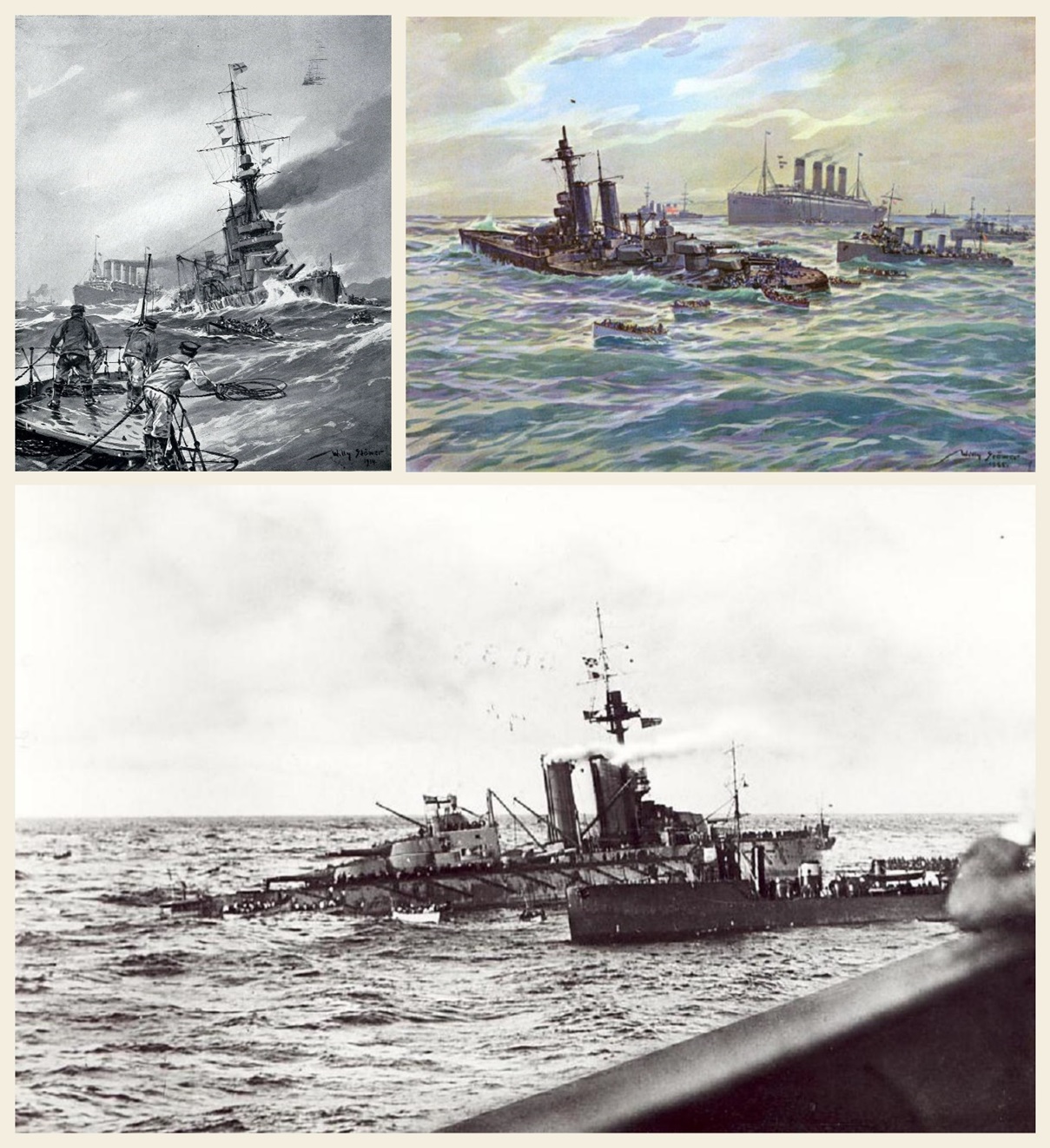
Figure 2: Contemporary painting of the H.M.S. AUDACIOUS and R.M.S. OLYMPIC made by famous German naval painter Willy Stöwer and a photograph taken by an American passenger aboard the ocean liner (in the foreground of the latter picture is the bulwark of the boatdeck, while lifeboats of the OLYMPIC can be seen at the stern of the damaged battleship).
The bow broken off due to the ammunition explosion is further away from the rest of the hull. Between the two parts of the hull lies the forward gun turret, which has fallen out of its original position, and the armored barbetta separated from it. The capsized hull is in the final stage of collapse, as the unarmoured parts of the hull gradually falls between the armored - and therefore extremely solid - side walls of the hull (the same process is just going on for similar reasons in case of the sunken Austro-Hungarian battleship SZENT ISTVÁN which is only 2 years younger than H.M.S. AUDACIOUS). Therefore, the accurate recording of the wreck and of the correlation between the parts of it, is a particularly important task, as with the final collapse, a significant part of the ship's explorable past will also be lost. With technology developed by Ger Dooly and his team, the capsized and disintegrated wreck was therefore virtually scanned. As it is a ship 182 m long and 27 m wide, this is no small task. Nevertheless, a remotely operated vehicle (ROV) wich can keep a constant depth under water and a constant distance from the wreck with the laser beam emitted by the attached detector, traveled through the wrecksite just like a 3D scanner on an object selected for digital fixing. The process thus provides a much more complete picture of the wreck and the wrecksite as a whole than what traditional diving expeditions would be able to do in the same amount of time. This technique therefore provides a more complete and detailed picture of the wreck than ever before, greatly aiding the research of them and reducing the risk of work, as the high-detail picture can be taken without even a single diver having to dive to the seafloor. This procedure is the most advanced and efficient way currently available to visually display wrecks.
The mapping of wrecks, the recording and display of data from on-site surveys has undergone long development. The first open-circuit scuba technology was designed by Jacques Yves Cousteau in 1942, and the first underwater camera was not constructed until 1963 (invented by Jean de Wouters). Until now, archaeologists involved in the work of divers have only been able to record the location and condition of a site and the finds found there, only by making drawings and reconstructive representations used in land archaeological excavations, ie by observation with the naked eye. The first major change was the underwater magnometer developed in 1953, the side-scan sonar published in 1954, and the sub-bottom profiler that has been prevalent since the 1960s. The magnetometer made it possible to separate metal and wood (so it could only be used for already known sites), and the sonar and sub-bottom profiler based on signal reflection drew the topography of the seafloor (making it easier to navigate) and helped identification of subsurface or other structures which burried with sediment. With the further development of the first underwater stereo cameras - developed between 1966-71 - the method of photogrammetry has been applied since 1991, which builds a three-dimensional image from two-dimensional photographs. Thanks to the development of 3D printing, this image itself can even be printed as well. All this helps research and museum pedagogy alike, as the finds become tangible to researchers and those interested.

Figure 3: During the exploration of sunken remains of the TITANIC, perhaps the most famous shipwreck in the world, researchers helped in their orientation and analytical work by a huge photographic mosaics composed of many thousands photographs. However, by the advance in technology, these static, two-dimensional images have acquired a rotatable, spatial representation. You can see above the photogrammetric 3D image of the forward gun-turret of H.M.S. AUDACIOUS torn from the overturned hull (Matt Carter, Barry McGill, 2017). The rotatable 3D model is available here.
The latest generation of tools to support shipwreck research is the underwater scanners used by Ger and his team and augmented reality (the current state is complemented by virtual reality), which is capable of spectacularly visualizing changes (especially attracting young interested age groups). The connected geoinformation system - GIS - combines and transforms the data extracted through all these tools and procedures into a database, which (even in the current live broadcast) can be freely forwarded, so it is one of the most effective tool for information sharing, which is one of the most important goal of the archeology in addition to information acquisition (survey and documentation).
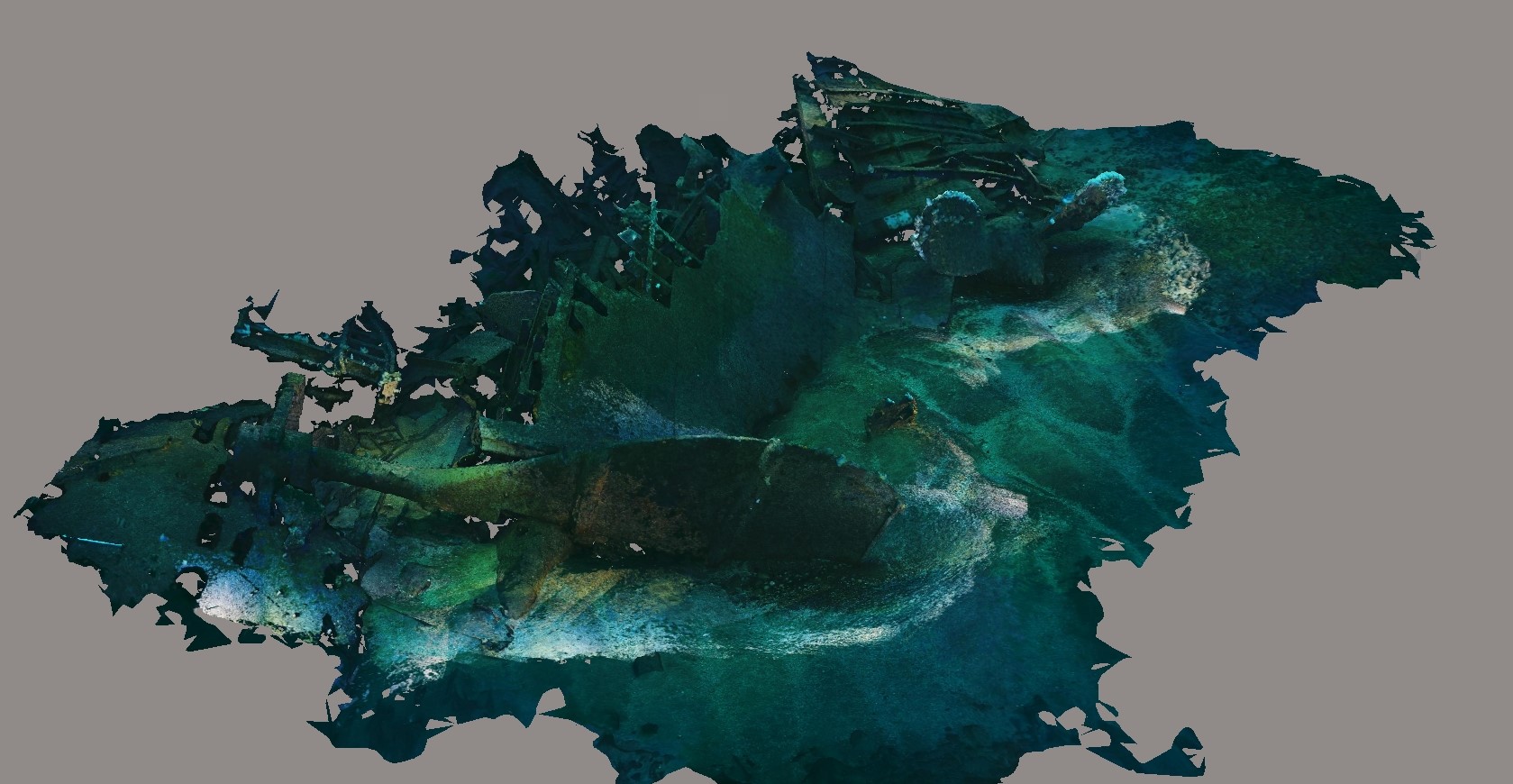
Figure 4: Results of a photogrammetric survey of the stern section of the JUSTICIA's (ex-STATENDAM's) wreck according to the progress made in July 2020. In the foreground of the picture is the rudder blade attached to the left-tilted stern post, and to the right in front of that (closer to the upper edge of the picture) are the two blades of the right propeller which is partially buried by the sediment. (Source University of Limerick, Ger Dooly, Indepth Technical Diving, SANTI diving TEAM, SANTI Diving, Big Blue Dive Lights).
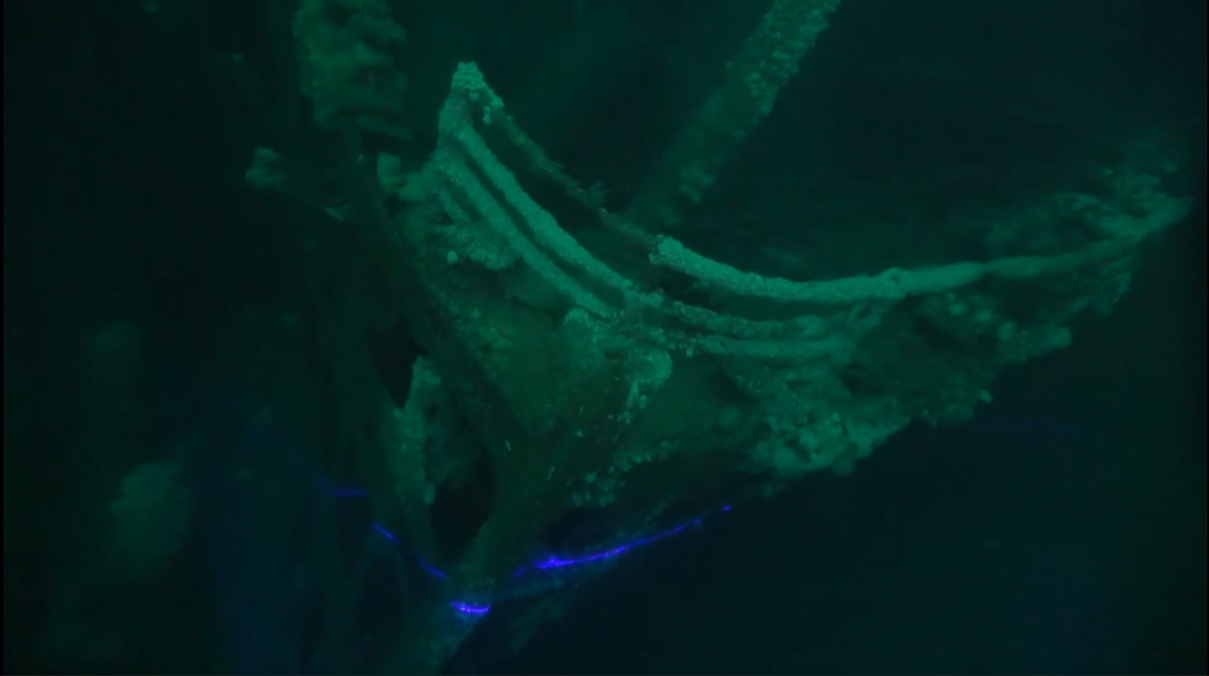
Figure 5: The underwater laser scanner in work, the at the tip of the bow of the JUSTICIA's wreck. Source.
During the conversation that accompanied the spectacular presentation, Barry McGill reported details of a series of research on the wreckage of H.M.S. AUDACIOUS, demonstrating how the strong current that can be felt everywhere in the shallow sea makes it difficult for divers, who can be swept away from their desired position on the one hand, and blinded them on the other hand by the sediment and by the fine-grained rust (which rises in clouds from the wreck during the sudden collapse of a larger structural element), kept in motion by the current, minimizing the visibility. At the same time, Barry did not fail to mention that the wildlife of the continental shelf is also present on the wreckage and sometimes a seal appears among the remains.
Tamás Balogh emphasized the importance of H.M.T. JUSTICIA (ex-STATENDAM), in this context, addressing in particular why the ship is often referred to as the “Dutch TITANIC”. With the scheduled construction of the sister ships OLYMPIC, TITANIC and GIGANTIC, the Harland & Wolff Shipyard in Belfast is prepared to mass-produce the highest quality ocean liners for any nation in the world. Thus, when the Dutch also ordered the type, the shipyard made - on the basis of TITANIC's plans - a slightly smaller vessel (which was the first ship constructed after the TITANIC's launch), optimized for shallower Dutch waters. In addition, the ship was the largest shipwreck sunk by torpedoes in World War I, and the infamous wolf pack tactics of the German submarines of World War II, were created during the sinking of this ship. However, the fierce German attempts to sink the ship at all costs was the result of a misidentification, when Otto von Schrader, the commander of the first German attacker, U-64, confused her with the similar German ocean liner VATERLAND (which remained in the neutral USA at the outbreak of the war, but by 1918, however, she had already transported American soldiers across the ocean against Germany, so the submarines of the German Navy competed with each other to try to sink her as soon as possible).
At the end of the conversation, Ger Dooly emphasized that they wanted to make it possible to apply this spectacularly advanced technology widely, thanks to the partnership of the university. (We note that this technology - with proper foresight and some luck - can even be used in the research of historical shipwrecks important to Hungary, such as the battleship SZENT ISTVÁN, which is a contemporary of H.M.S. AUDACIOUS). The interlocutors then thanked for the spectacular presentation. Barry expressed the hope that the survey, which had begun at the two major sites, could be continued out together as soon as possible and, if possible, that the technology could be used in the exploration of another historic wreck, the LUSITANIA, near to the south coast of Ireland. Tamás Balogh pointed out that a thorough photogrammetric and laser survey covering every detail is probably the most modern technology to implement Dr. Robert Ballard's idea from the 1990s, the virtual deep sea museum.
In any case, with the help of the presented infrastructure, anybody can take a virtual tour at any shipwreck and wreck site, and the image of shipwrecks can be maintained forever. Without having to move anything out of place, or without having to worry about the original material, which - in its previously known form - gradually disappearing during the years. In this way, this technology not only preserve the cultural heritage, but it also makes it much more spectacular than any previous visualization options, making the context easier to understand for those who are less experienced in wreckdiving. Just like the 3D reconstructive animations which shows the original appearance of the ships, of which the latest work represents the H.M.T. JUSTICIA (ex-STATENDAM) which was presented as a farewell to those who are interested in.

Figure 6: Some movie frames from the animation showing STATENDAM (Source: Dr. Tamás Balogh).
It would be great if you like the article and pictures shared. If you are interested in the works of the author, you can find more information about the author and his work on the Encyclopedia of Ocean Liners Fb-page.
If you would like to share the pictures, please do so by always mentioning the artist's name in a credit in your posts. Thank You!

-
Detailed overview made for the first time, mapping the wreckage of the HMHT JUSTICIA, sunk in 1918
On March 1, 2020, second episode of the "Shipwreck Secrets", of the Discovery Science TV-channel in the United States, was broadcast (will be on screen also in the rest of the world in the coming months). This second episode of the six-part series, introduces the history of the sinking of his majesty's hired trannsport vessel HMHT JUSTICIA (converted from the dutch ocean liner STATENDAM) and an on-site analysis of the wreckage off the Atlantic coast of Donegal, Ireland.
The president of our association, Dr. Tamás Balogh, who launched his book on the history of the ship at the Harland & Wolff Shipyard in Belfast in 2018, and as a result, he was invited to participate in the contribution to the production of the film. The exciting expedition and filmmaking took place in May 2019, followed by the post-production was resulted a one-hour film, which was presented to those interested on March 1, 2020.
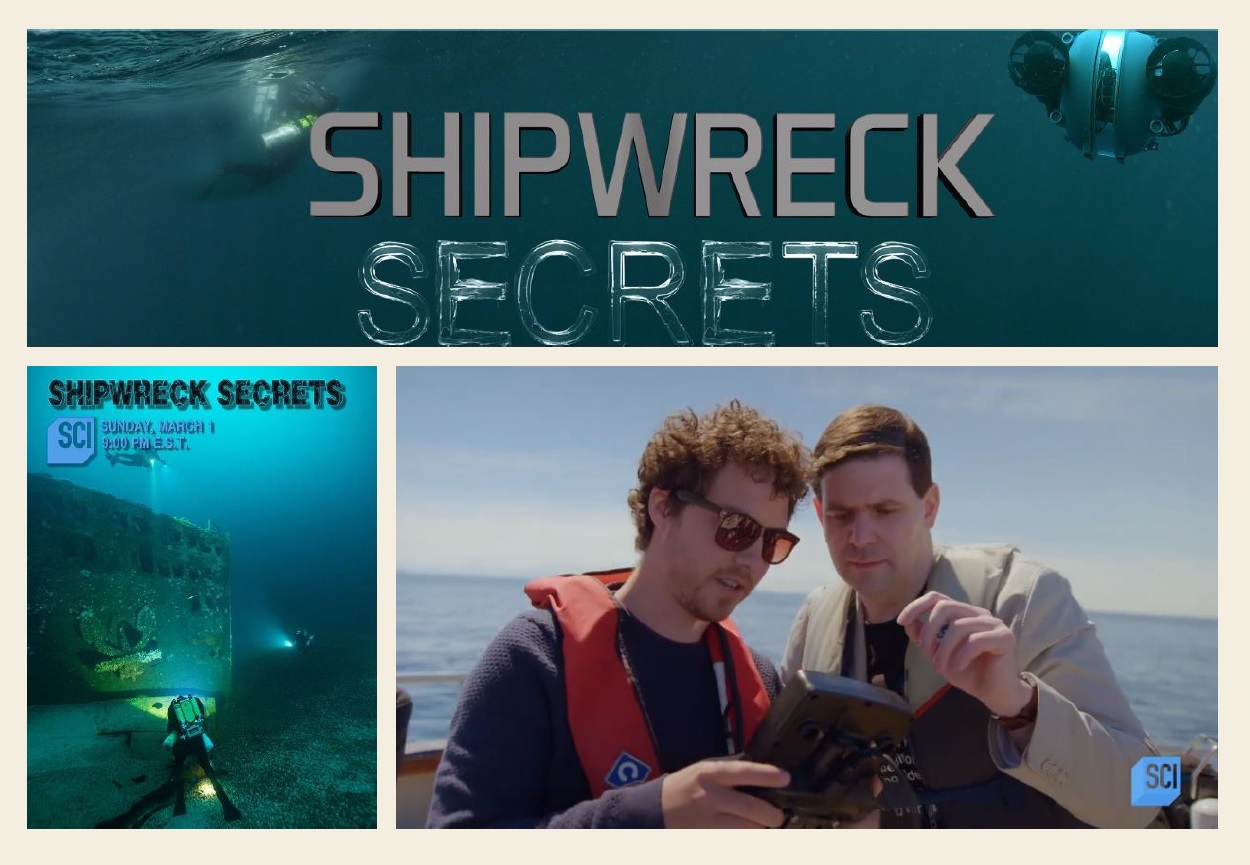
Figure 1: Logo of the TV-series, poster of the second episode, and a scene (source: Shipwreck Secrets).
The most important result of the work is that 100 years after the ship sank, the first complete and comprehensive survey of the wrecksite was completed. The exact resting place of the wreck has been identified by the divers Norman and Simon Bamford, and Leight Bishop, a well-known underwater photographer, has regularly captured great underwater photographs from the mid-1990s, which have made the ship widely known since 1998. Some details, such as the bow, were captured on iconic images and inspired dozens of divers, but little was known about the ship as a whole.
At least a comprehensive picture of the wrecksite as a whole was obtained when the first SONAR image of the wrecksite was taken in 2005 as part of the Irish National Seabed Survey. This image showed mainly the spatial location of the wreckage and the depth data, showing the lowest and highest elevations of the wreck with a color scale. Although all details are missing from this picture, some basic facts (as compared to previous close-ups made by the scuba divers) have become clear. It turned out, for example, that the ship, which is in the way of strong sea currents, had collapsed and that the once 237 m long, 26 m wide hull was scattered over a wrecksite of about 300 m long and a good 50 m wide. The currents, for example, swept the superstructure to the left side of the ship, and today only parts of the hull below the former waterline remained more or less intact. Everything else was broken into small pieces, turning the magnificent ocean liner into a jigsaw puzzle.
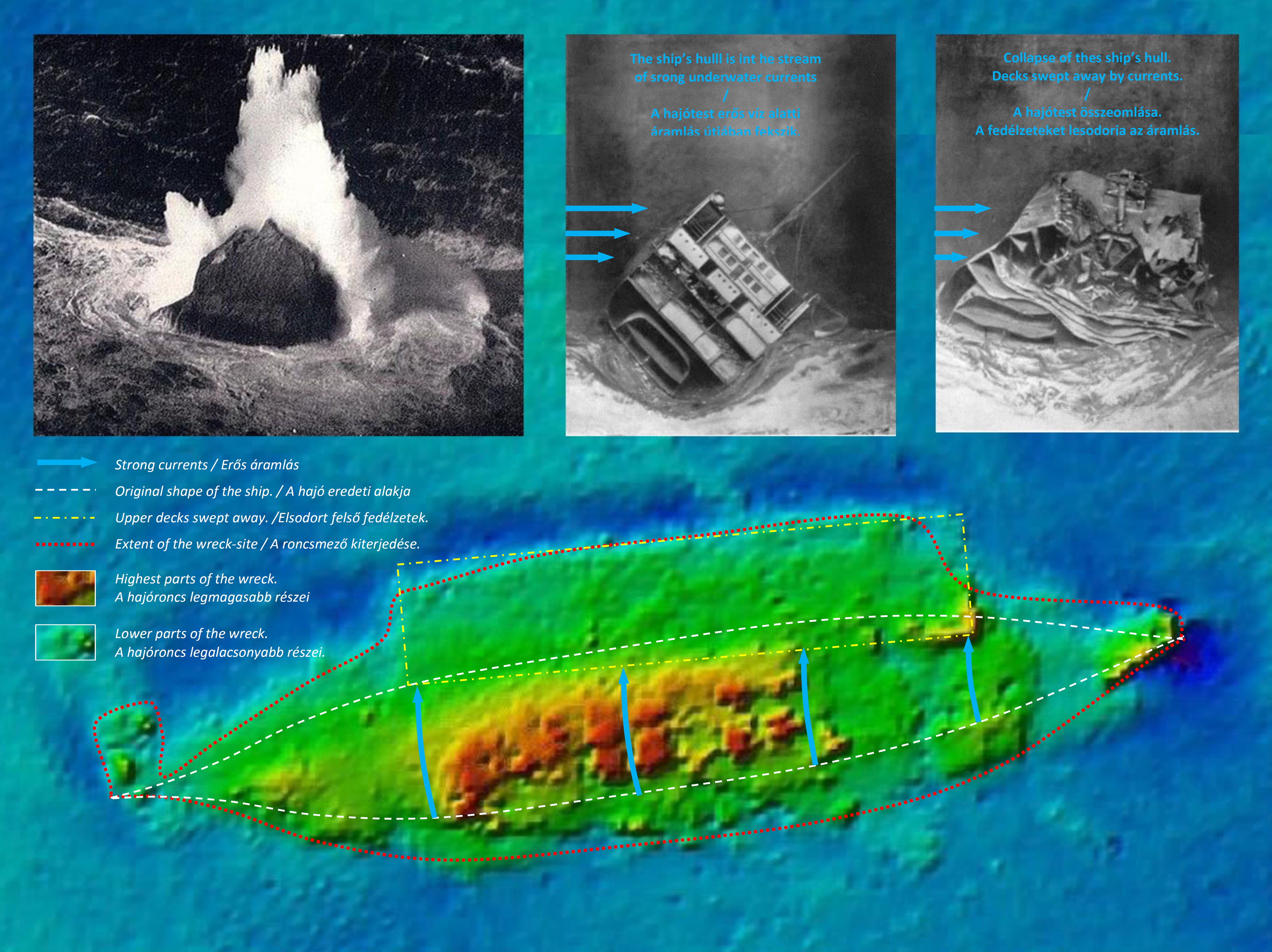
Figure 2: The SONAR image of the wreck and the main features it identifies, showing the environmental conditions leading to the collapse and the process of it (source: Dr. Tamás Balogh, using the Sonar image of INFOMAR).
Norman Woods attempted to assemble the parts of this jigsaw puzzles for the first time in 2014, capturing the underwater footage of larger areas of the wreckage by attaching his GoPro camera to his scooter, so he was able to swim along the full length of the ship from bow to stern and back again only in 13 minutes. However, he was not able to go to the sides, far away from the ship's former centerline, leaving many uncharted areas in the wreckage and waiting to be identified.
These information helped to determine the starting points of current research and to design and conduct a new survey. As a result, Dr. Tamás Balogh prepared the first complete representation of HMT JUSTICIA's resting place, which can be seen here for the first time.
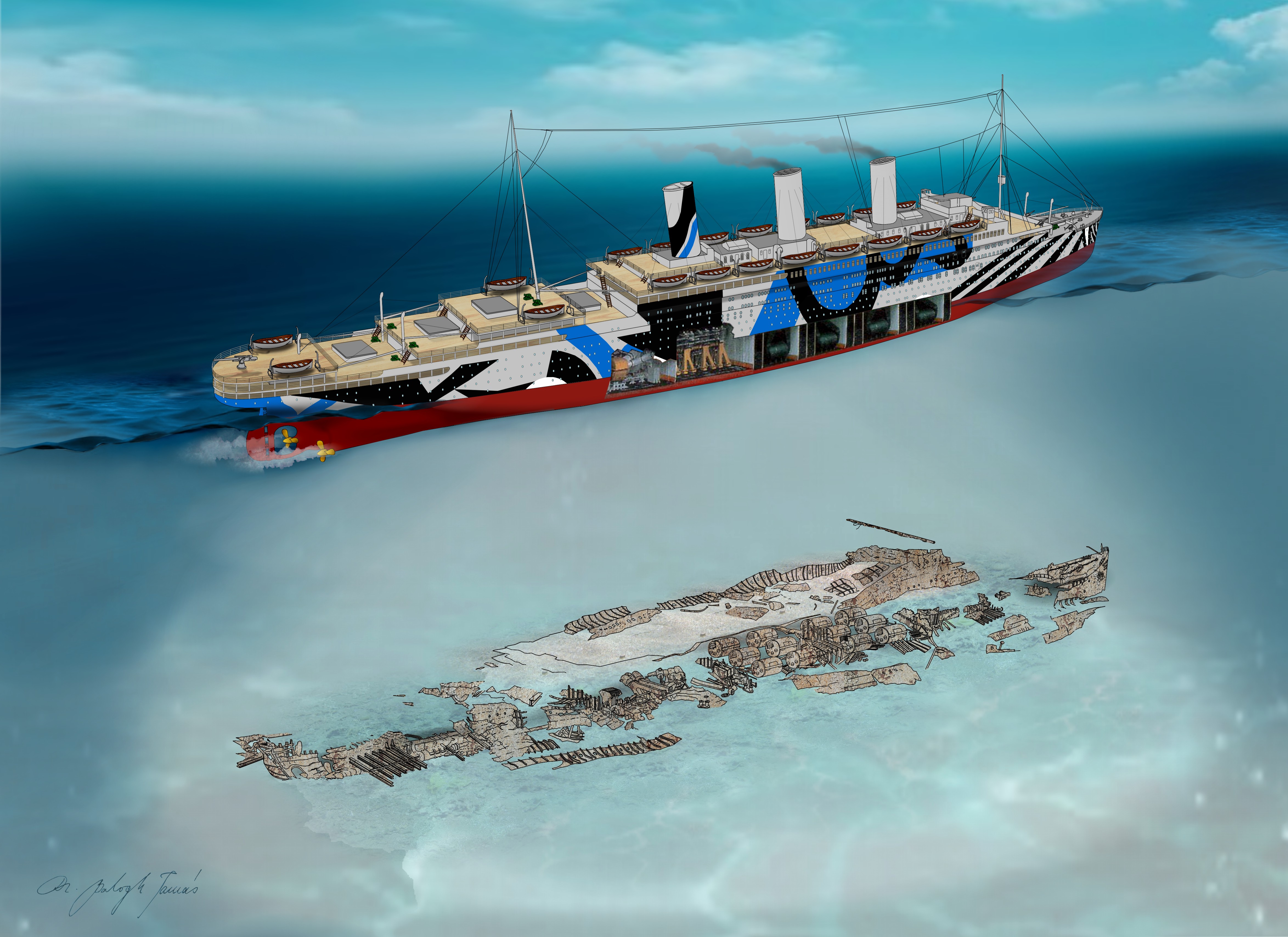
Figure 3: 1918-2018 - HMHT JUSTICIA and its Wreckage (created by Dr. Tamás Balogh, © 2020).

Figure 4: Outline drawing of the wreckage field, identifying the exact origin of the components there (by Dr. Tamás Balogh, © 2020).
By the end of the research, we were able to identify that which was the former (original) position on the ship of some larger structural units laying on the wrecksite, which also helps to better understand and reconstruct the deformation and disintegration process of the shipwreck. It was a great surprise that the walls of the watertight compartments in the lower part of the hull, can still be seen around the engines and the boiler rooms, everywhere on the ship. These walls specially strengthened after the TITANIC disaster regarding that the JUTICIA was the first ocean liner built after the sinking of the TITANIC, where the new safety regulations could be applied. Also new was the identification of the ship's fallen foremast. Unfortunately, however, it has also been confirmed that the natural deterioration of the wreck has accelerated and that even the small details that are still recognizable will soon disappear.
But before that could happen in the future, our expedition however, was able to record the condition of the wrecks and thanks to our work, the picture we know of them in 2019 is now preserved. It was a great opportunity and I'm grateful that I was able to take part in that. Thank you all!
Credits:
Filmmakers:
- Loubna Turjuman Genovese, Producer;
- Matt Bone, Producer;
- Quincy Andrews, Drone operator;
- Jonathan Young, Cameraman;
- Liam Scott, Technical support.
Divers:
- Barry McGill, Leading Diver;
- Garet O’Neil, diver;
- Stewart Andrews diver;
- Kevin McShane, Support Diver;
- Pat Coughlan Support Diver;
- Michael McVeigh, Skipper.
More about the expedition:
https://m.blog.hu/ha/hajosnep/image/008_deadly_pair_diving_in_donegal.pdf
Further wreck-diving expeditions with Tamás Balogh:
Between 2003 and 2008 he was involved in the research of the shipwrecks of the Austro-Hungarian Monarchy on the Adriatic (the destroyer STREITER, the cruiser ZENTA and the battleship SZENT ISTVÁN).
Attila Dávid Molnár made a series of films about the research (episodes made about STREITER, ZENTA and SZENT ISTVÁN were also shown on Spektrum television).
In 2016, on the 100th anniversary of the Battle of the Jutland, he was a historian of a largescale expedition with 60 divers from 15 countries and was the author of some articles on the results of the expedition.
-
Első ízben látható az 1918-ban elsüllyedt JUSTICIA óceánjáró roncstérképe
2020. március 1-én került adásba a Discovery Science televíziós csatornán az Egyesült Államokban (a következő hónapokban pedig a világ többi részén) a „Hajóroncsok titkai” - Shipwreck Secrets - c. hatrészes sorozat második epizódja, amely a HMT JUSTICIA (ex-STATENDAM) óceánjáró csapatszállító hajó elsüllyesztésének történetét és az északi ír partok előtt, az Atlanti-óceánban nyugvó roncsainak helyszíni elemzését mutatja be.
A film elkészítésében szakértőként közreműködött egyesületünk elnöke, Dr. Balogh Tamás, aki 2018-ban – a hajó elsüllyedésének századik évfordulóján – a belfasti Harland & Wolff Hajógyárban mutatta be az érdeklődőknek a hajó történetéről szóló „Dutch Titanic” c. könyvét. Ennek köszönhetően kapott felkérést a munkában való közreműködésre. Az eseménydús expedícióra és a filmforgatásra 2019 májusában került sor, az utómunkákat követően pedig elkészült az eredményeket összegző egyórás film, amit 2020. március 1-én mutattak be az érdeklődőknek.

1. ábra: A filmsorozat logója, a második epizód plakátja és egy jelenete (forrás: Shipwreck Secrets).
A munka legfontosabb eredménye az, hogy a hajó elsüllyedése után száz esztendővel elkészült a roncsmező első teljes és átfogó felmérése. A roncs pontos nyughelyét Norman és Simon Bamford búvárok azonosították, Leight Bishop ismert búvárfotós pedig az 1990-es évek közepétől készített rendszeresen nagyszerű víz alatti fénykép-felvételeket, amelyek 1998-tól kezdve széles körben ismertté tették a hajót. Egyes részletek – mint például a hajóorr – nagy hatású, ikonikus felvételeken nyertek bemutatást és búvárok tucatjait inspirálták, de a hajó egészéről ekkor még keveset lehetett tudni.
A roncsmező egészéről legalább átfogó képet akkor sikerült kapni, amikor az Ír Országos Tengerfenék-felmérés keretében 2005-ben elkészítették a roncsok első SONAR-képét. Ez a felvétel leginkább a roncsok térbeli elhelyezkedését és a mélység-adatokat mutatta be színskálával érzékeltetve a roncs legalacsonyabban fekvő, illetve a legmagasabbra emelkedő részeit. Bár erről a képről minden részlet hiányzik, néhány alapvető fontosságú tény azonban (az egyes részleteket közelről bemutató korábbi búvárfotókkal összevetve) már világossá vált. Kiderült például, hogy az erős tengeri áramlások útjában fekvő hajó, szétesett, s az egykor 237 m hosszú, 26 m széles hajótest alkotóelemei egy nagyjából 300 m hosszú és jó 50 m széles roncsmezőn szóródtak szét. Az áramlások a felépítményt például a hajó bal oldalára sodorták, a hajótestből pedig mára lényegében csak az egykori vízvonal alatti részek maradtak többé-kevésbé egyben. Minden más apró darabokra tört, jókora kirakóssá alakítva ezzel a hajdan fenséges óceánjárót.

2. ábra: A roncs SONAR-képe és az arról felismerhető főbb jellegzetességek az összeomlásához vezető környezeti viszonyok és az összeomlás folyamatának bemutatásával (forrás: Dr. Balogh Tamás, az INFOMAR Sonar-képének felhasználásával).
A kirakós mozaikdarabkáit első ízben Norman Woods kísérelte meg összeilleszteni, akinek 2014-ben elsőként sikerült a roncsmező nagyobb területeit összefüggően bemutató víz alatti filmfelvételt készítenie úgy, hogy GoPro kameráját a búvárvontatójához rögzítette, így 13 perc alatt képes volt oda-vissza végigúszni a hatalmas hajó hossztengelye mentén. Neki sem sikerült azonban túlságosan eltávolodnia a hajó egykori középvonalától, így a roncsmezőn számos feltérképezetlen terület maradt még és vár azonosításra.
Ezek az információk segítették a mostani kutatás kiindulópontjainak meghatározását és az újabb felmérés megtervezését és elvégzését. Ennek eredményeként készíthette el Dr. Balogh Tamás a HMT JUSTICIA nyughelyének első teljes ábrázolását, amelyet itt láthatnak első ízben az érdeklődők.

3. ábra: 1918-2018 - A HMT JUSTICIA és roncsai (készítette: Dr. Balogh Tamás, © 2020).

4. ábra: A roncsmező áttekintő rajza az ott található alkatrészek pontos származási helyének azonosításával (készítette: Dr. Balogh Tamás, © 2020).
A kutatás végére sikerült azonosítani a roncson megtalálható egyes nagyobb szerkezeti egységek egykori – a hajón lévő eredeti – pozícióját, ami a hajótest összeroskadásához és széteséséhez vezető torzulási folyamat jobb megértéséhez és rekonstrukciójához is segítséget nyújt. Nagy meglepetés volt, hogy a hajótest víz alatti részében elhelyezett és a TITANIC katasztrófája után különlegesen megerősített vízmentes rekeszek (a JUTICIA a volt a TITANIC elsüllyedése után épített első óceánjáró, ahol az új biztonsági előírásokat alkalmazhatták) nyomásálló falai még ma is állnak és a kazánházak, illetve a gépházak körül most is láthatók végig, mindenütt az egész hajón. Ugyancsak újdonságot jelentett a hajó kidőlt előárbocának azonosítása. Sajnos azonban az is megerősítést nyert, hogy a roncs állapotának természetes romlása felgyorsult és a még felismerhető kevés részlet is hamarosan végképp eltűnik a szemünk elől.
Ám expedíciónk még ezelőtt rögzíthette a hajóroncsok állapotát, így a róluk 2019-ben ismert kép - az elvégzett munkának köszönhetően - most már fennmarad. Nagyszerű lehetőség volt ez. Köszönet érte mindenkinek!
Stáb:
Filmes:
- Loubna Turjuman Genovese, sorozat-szerkesztő;
- Matt Bone, producer;
- Quincy Andrews, drón-kezelő;
- Jonathan Young, operatőr;
- Liam Scott, segítő.
Búvár:
- Barry McGill, merülés-vezető főbúvár;
- Garet O’Neil, merülő búvár;
- Stewart Andrews merülő búvár;
- Kevin McShane, fedélzeti segítő búvár;
- Pat Coughlan fedélzeti segítő búvár;
- Michael McVeigh, kapitány.
További információk az expedícióról:
https://m.blog.hu/ha/hajosnep/image/006_justicia_ub124_expedicio_2019052125.pdf
További roncskutató expedíciók Balogh Tamás közreműködésével:
2003-2008 között az Osztrák-Magyar Monarchia Haditengerészetének az Adrián elsüllyedt hajóroncsai (a STREITER romboló, a ZENTA cirkáló és a SZENT ISTVÁN csatahajó) kutatásában közreműködött.
A kutatásról Molnár Attila Dávid készített filmsorozatot (a STREITER-ről, a ZENTA-ról és a SZENT ISTVÁN-ról készült filmeket egyebek között a Spektrum televízió is bemutatta).
2016-ban a jütlandi tengeri ütközet századik évfordulóján egy nagyméretű, 15 országból érkezett 60 búvár részvételével folytatott expedíció történeti szakértője és az expedíció eredményeiről szóló beszámoló készítője volt.